English soldiers normandy Black & White Stock Photos
(55)See english soldiers normandy stock video clipsEnglish soldiers normandy Black & White Stock Photos
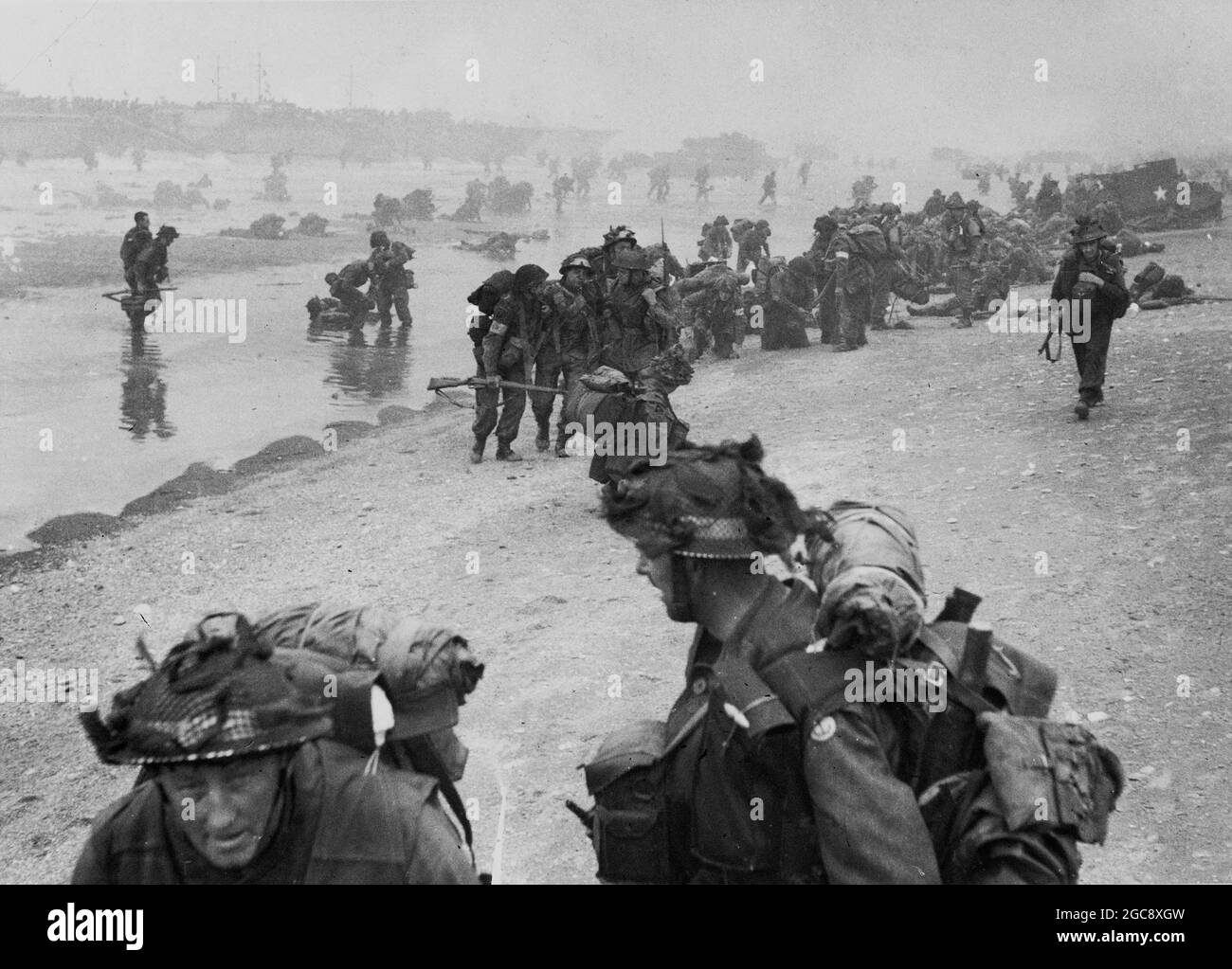 SWORD BEACH, NORMANDY, FRANCE - 06 June 1944 - British troops on Queen Beach, Sword Area at approx. 8:30am 6th June 1944. Soldiers of No.1 Platoon, 84 Stock Photohttps://www.alamy.com/image-license-details/?v=1https://www.alamy.com/sword-beach-normandy-france-06-june-1944-british-troops-on-queen-beach-sword-area-at-approx-830am-6th-june-1944-soldiers-of-no1-platoon-84-image437831545.html
SWORD BEACH, NORMANDY, FRANCE - 06 June 1944 - British troops on Queen Beach, Sword Area at approx. 8:30am 6th June 1944. Soldiers of No.1 Platoon, 84 Stock Photohttps://www.alamy.com/image-license-details/?v=1https://www.alamy.com/sword-beach-normandy-france-06-june-1944-british-troops-on-queen-beach-sword-area-at-approx-830am-6th-june-1944-soldiers-of-no1-platoon-84-image437831545.htmlRM2GC8XGW–SWORD BEACH, NORMANDY, FRANCE - 06 June 1944 - British troops on Queen Beach, Sword Area at approx. 8:30am 6th June 1944. Soldiers of No.1 Platoon, 84
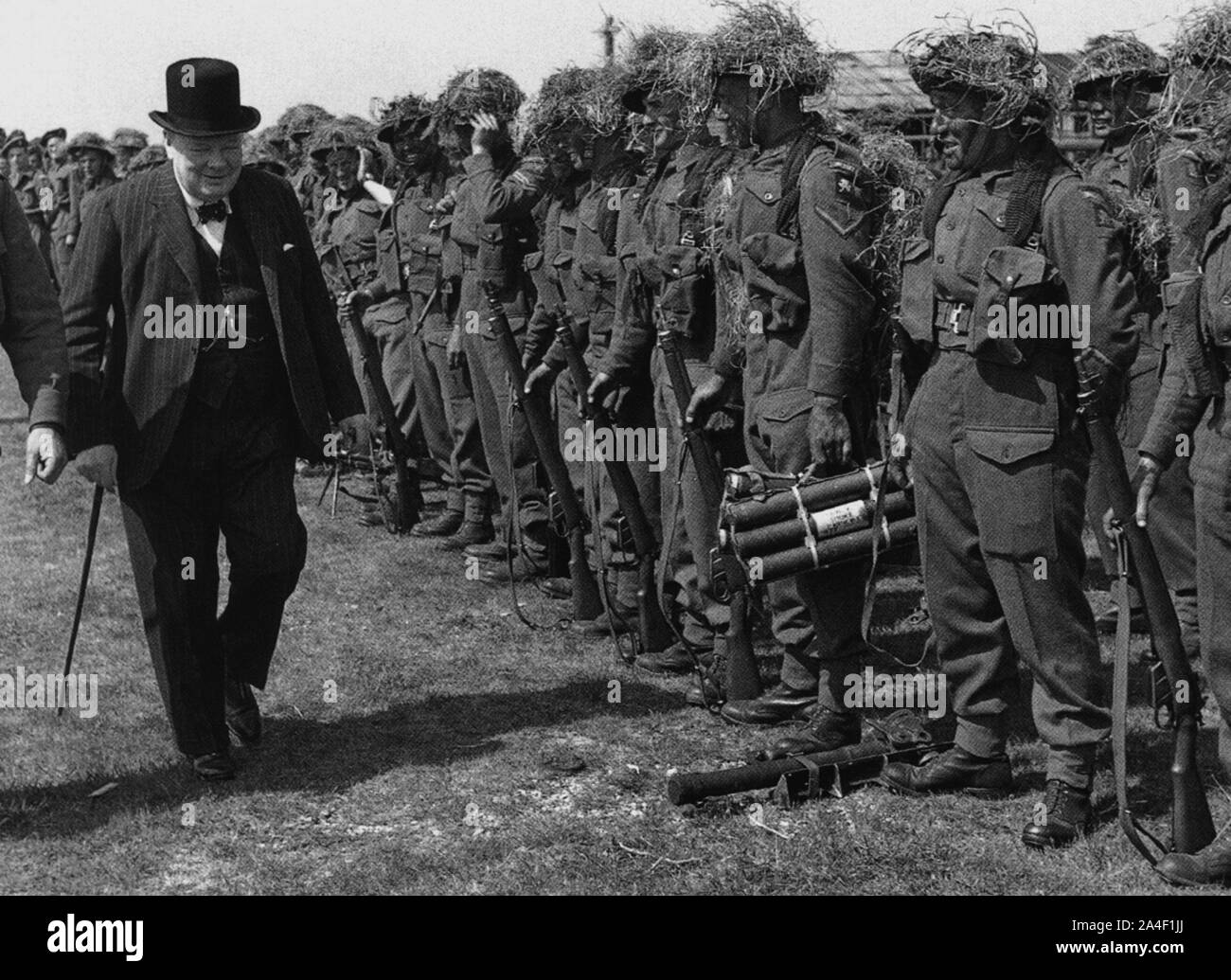 Winston Churchill inspecting British infantry prior to D-day. May 1944 Stock Photohttps://www.alamy.com/image-license-details/?v=1https://www.alamy.com/winston-churchill-inspecting-british-infantry-prior-to-d-day-may-1944-image329786202.html
Winston Churchill inspecting British infantry prior to D-day. May 1944 Stock Photohttps://www.alamy.com/image-license-details/?v=1https://www.alamy.com/winston-churchill-inspecting-british-infantry-prior-to-d-day-may-1944-image329786202.htmlRF2A4F1JJ–Winston Churchill inspecting British infantry prior to D-day. May 1944
 Robert Curthose(1051–1134), son of William the Conqueror, was Duke of Normandy from 1087 until 1106 and an unsuccessful claimant to the English throne. He fled to the court of his uncle Robert I, Count of Flanders, but caused mayhem. At a battle in January 1079, Robert unhorsed King William in combat and succeeded in wounding him. He stopped his attack when he recognised his father's voice. King William cursed his son, then raised the siege and returned to Rouen. At Easter 1080, father and son were reunited by the efforts of Queen Matilda, and a truce lasted until she died in 1083. Stock Photohttps://www.alamy.com/image-license-details/?v=1https://www.alamy.com/robert-curthose10511134-son-of-william-the-conqueror-was-duke-of-normandy-from-1087-until-1106-and-an-unsuccessful-claimant-to-the-english-throne-he-fled-to-the-court-of-his-uncle-robert-i-count-of-flanders-but-caused-mayhem-at-a-battle-in-january-1079-robert-unhorsed-king-william-in-combat-and-succeeded-in-wounding-him-he-stopped-his-attack-when-he-recognised-his-fathers-voice-king-william-cursed-his-son-then-raised-the-siege-and-returned-to-rouen-at-easter-1080-father-and-son-were-reunited-by-the-efforts-of-queen-matilda-and-a-truce-lasted-until-she-died-in-1083-image185844819.html
Robert Curthose(1051–1134), son of William the Conqueror, was Duke of Normandy from 1087 until 1106 and an unsuccessful claimant to the English throne. He fled to the court of his uncle Robert I, Count of Flanders, but caused mayhem. At a battle in January 1079, Robert unhorsed King William in combat and succeeded in wounding him. He stopped his attack when he recognised his father's voice. King William cursed his son, then raised the siege and returned to Rouen. At Easter 1080, father and son were reunited by the efforts of Queen Matilda, and a truce lasted until she died in 1083. Stock Photohttps://www.alamy.com/image-license-details/?v=1https://www.alamy.com/robert-curthose10511134-son-of-william-the-conqueror-was-duke-of-normandy-from-1087-until-1106-and-an-unsuccessful-claimant-to-the-english-throne-he-fled-to-the-court-of-his-uncle-robert-i-count-of-flanders-but-caused-mayhem-at-a-battle-in-january-1079-robert-unhorsed-king-william-in-combat-and-succeeded-in-wounding-him-he-stopped-his-attack-when-he-recognised-his-fathers-voice-king-william-cursed-his-son-then-raised-the-siege-and-returned-to-rouen-at-easter-1080-father-and-son-were-reunited-by-the-efforts-of-queen-matilda-and-a-truce-lasted-until-she-died-in-1083-image185844819.htmlRMMP9XXY–Robert Curthose(1051–1134), son of William the Conqueror, was Duke of Normandy from 1087 until 1106 and an unsuccessful claimant to the English throne. He fled to the court of his uncle Robert I, Count of Flanders, but caused mayhem. At a battle in January 1079, Robert unhorsed King William in combat and succeeded in wounding him. He stopped his attack when he recognised his father's voice. King William cursed his son, then raised the siege and returned to Rouen. At Easter 1080, father and son were reunited by the efforts of Queen Matilda, and a truce lasted until she died in 1083.
 British infantry in Normandy 1914 Stock Photohttps://www.alamy.com/image-license-details/?v=1https://www.alamy.com/stock-photo-british-infantry-in-normandy-1914-56690820.html
British infantry in Normandy 1914 Stock Photohttps://www.alamy.com/image-license-details/?v=1https://www.alamy.com/stock-photo-british-infantry-in-normandy-1914-56690820.htmlRMD86DM4–British infantry in Normandy 1914
 Norman Thanksgiving following the Battle of Hastings fought on 14 October 1066 between the Norman-French army of William, the Duke of Normandy, and an English army under the Anglo-Saxon King Harold Godwinson, beginning the Norman conquest of England. It took place approximately 7 miles (11 kilometres) northwest of Hastings, close to the present-day town of Battle, East Sussex, and was a decisive Norman victory. Stock Photohttps://www.alamy.com/image-license-details/?v=1https://www.alamy.com/norman-thanksgiving-following-the-battle-of-hastings-fought-on-14-october-1066-between-the-norman-french-army-of-william-the-duke-of-normandy-and-an-english-army-under-the-anglo-saxon-king-harold-godwinson-beginning-the-norman-conquest-of-england-it-took-place-approximately-7-miles-11-kilometres-northwest-of-hastings-close-to-the-present-day-town-of-battle-east-sussex-and-was-a-decisive-norman-victory-image185094769.html
Norman Thanksgiving following the Battle of Hastings fought on 14 October 1066 between the Norman-French army of William, the Duke of Normandy, and an English army under the Anglo-Saxon King Harold Godwinson, beginning the Norman conquest of England. It took place approximately 7 miles (11 kilometres) northwest of Hastings, close to the present-day town of Battle, East Sussex, and was a decisive Norman victory. Stock Photohttps://www.alamy.com/image-license-details/?v=1https://www.alamy.com/norman-thanksgiving-following-the-battle-of-hastings-fought-on-14-october-1066-between-the-norman-french-army-of-william-the-duke-of-normandy-and-an-english-army-under-the-anglo-saxon-king-harold-godwinson-beginning-the-norman-conquest-of-england-it-took-place-approximately-7-miles-11-kilometres-northwest-of-hastings-close-to-the-present-day-town-of-battle-east-sussex-and-was-a-decisive-norman-victory-image185094769.htmlRMMN3P7D–Norman Thanksgiving following the Battle of Hastings fought on 14 October 1066 between the Norman-French army of William, the Duke of Normandy, and an English army under the Anglo-Saxon King Harold Godwinson, beginning the Norman conquest of England. It took place approximately 7 miles (11 kilometres) northwest of Hastings, close to the present-day town of Battle, East Sussex, and was a decisive Norman victory.
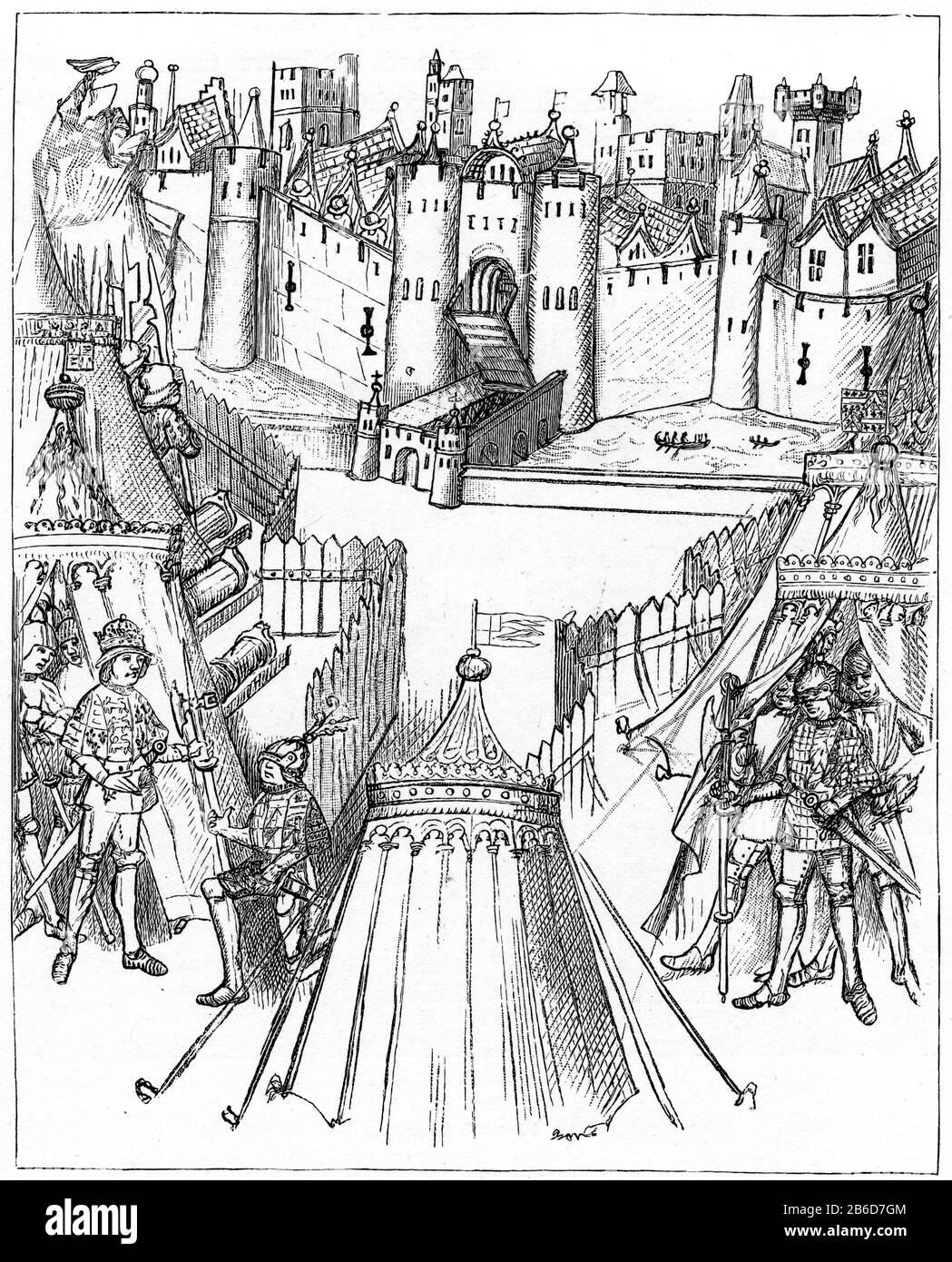 Siege of Rouen, 1418. Richard Beauchamp, Earl of Warwick (1382-1439), with Henry V (1386-1422) at the siege of Rouen, 1418. The Siege of Rouen (29 July 1418 - 19 January 1419) was a major event in the Hundred Years' War, where English forces loyal to Henry V captured Rouen, the capital of Normandy, from the Norman French. From The Beauchamp Pageants c1485. Stock Photohttps://www.alamy.com/image-license-details/?v=1https://www.alamy.com/siege-of-rouen-1418-richard-beauchamp-earl-of-warwick-1382-1439-with-henry-v-1386-1422-at-the-siege-of-rouen-1418-the-siege-of-rouen-29-july-1418-19-january-1419-was-a-major-event-in-the-hundred-years-war-where-english-forces-loyal-to-henry-v-captured-rouen-the-capital-of-normandy-from-the-norman-french-from-the-beauchamp-pageants-c1485-image348186628.html
Siege of Rouen, 1418. Richard Beauchamp, Earl of Warwick (1382-1439), with Henry V (1386-1422) at the siege of Rouen, 1418. The Siege of Rouen (29 July 1418 - 19 January 1419) was a major event in the Hundred Years' War, where English forces loyal to Henry V captured Rouen, the capital of Normandy, from the Norman French. From The Beauchamp Pageants c1485. Stock Photohttps://www.alamy.com/image-license-details/?v=1https://www.alamy.com/siege-of-rouen-1418-richard-beauchamp-earl-of-warwick-1382-1439-with-henry-v-1386-1422-at-the-siege-of-rouen-1418-the-siege-of-rouen-29-july-1418-19-january-1419-was-a-major-event-in-the-hundred-years-war-where-english-forces-loyal-to-henry-v-captured-rouen-the-capital-of-normandy-from-the-norman-french-from-the-beauchamp-pageants-c1485-image348186628.htmlRM2B6D7GM–Siege of Rouen, 1418. Richard Beauchamp, Earl of Warwick (1382-1439), with Henry V (1386-1422) at the siege of Rouen, 1418. The Siege of Rouen (29 July 1418 - 19 January 1419) was a major event in the Hundred Years' War, where English forces loyal to Henry V captured Rouen, the capital of Normandy, from the Norman French. From The Beauchamp Pageants c1485.
 After seizing the English Crown, Henry I of England took possession of the castle at Gisors, a fortress of strategic importance commanding the road between Rouen and Paris. This violated an earlier agreement between Henry and French King Louis VI that Gisors should remain neutral. Henry refused to relinquish Gisors and war broke. Ten years later, Louis's troops were routed in the Battle of Bremule, in August 1119. Louis met with Henry at Gisors in November 1120. The terms of the peace included a return of all territories captured by both kings with the exception of Gisors. Stock Photohttps://www.alamy.com/image-license-details/?v=1https://www.alamy.com/after-seizing-the-english-crown-henry-i-of-england-took-possession-of-the-castle-at-gisors-a-fortress-of-strategic-importance-commanding-the-road-between-rouen-and-paris-this-violated-an-earlier-agreement-between-henry-and-french-king-louis-vi-that-gisors-should-remain-neutral-henry-refused-to-relinquish-gisors-and-war-broke-ten-years-later-louiss-troops-were-routed-in-the-battle-of-bremule-in-august-1119-louis-met-with-henry-at-gisors-in-november-1120-the-terms-of-the-peace-included-a-return-of-all-territories-captured-by-both-kings-with-the-exception-of-gisors-image186656818.html
After seizing the English Crown, Henry I of England took possession of the castle at Gisors, a fortress of strategic importance commanding the road between Rouen and Paris. This violated an earlier agreement between Henry and French King Louis VI that Gisors should remain neutral. Henry refused to relinquish Gisors and war broke. Ten years later, Louis's troops were routed in the Battle of Bremule, in August 1119. Louis met with Henry at Gisors in November 1120. The terms of the peace included a return of all territories captured by both kings with the exception of Gisors. Stock Photohttps://www.alamy.com/image-license-details/?v=1https://www.alamy.com/after-seizing-the-english-crown-henry-i-of-england-took-possession-of-the-castle-at-gisors-a-fortress-of-strategic-importance-commanding-the-road-between-rouen-and-paris-this-violated-an-earlier-agreement-between-henry-and-french-king-louis-vi-that-gisors-should-remain-neutral-henry-refused-to-relinquish-gisors-and-war-broke-ten-years-later-louiss-troops-were-routed-in-the-battle-of-bremule-in-august-1119-louis-met-with-henry-at-gisors-in-november-1120-the-terms-of-the-peace-included-a-return-of-all-territories-captured-by-both-kings-with-the-exception-of-gisors-image186656818.htmlRMMRJXJX–After seizing the English Crown, Henry I of England took possession of the castle at Gisors, a fortress of strategic importance commanding the road between Rouen and Paris. This violated an earlier agreement between Henry and French King Louis VI that Gisors should remain neutral. Henry refused to relinquish Gisors and war broke. Ten years later, Louis's troops were routed in the Battle of Bremule, in August 1119. Louis met with Henry at Gisors in November 1120. The terms of the peace included a return of all territories captured by both kings with the exception of Gisors.
 Original Film Title: TESTA DI SBARCO PER OTTO IMPLACABII. English Title: HELL IN NORMANDY. Film Director: ALFONSO BRESCIA. Year: 1968. Stars: GUY MADISON. Credit: ALCINTER / Album Stock Photohttps://www.alamy.com/image-license-details/?v=1https://www.alamy.com/original-film-title-testa-di-sbarco-per-otto-implacabii-english-title-hell-in-normandy-film-director-alfonso-brescia-year-1968-stars-guy-madison-credit-alcinter-album-image207670232.html
Original Film Title: TESTA DI SBARCO PER OTTO IMPLACABII. English Title: HELL IN NORMANDY. Film Director: ALFONSO BRESCIA. Year: 1968. Stars: GUY MADISON. Credit: ALCINTER / Album Stock Photohttps://www.alamy.com/image-license-details/?v=1https://www.alamy.com/original-film-title-testa-di-sbarco-per-otto-implacabii-english-title-hell-in-normandy-film-director-alfonso-brescia-year-1968-stars-guy-madison-credit-alcinter-album-image207670232.htmlRMP1T5E0–Original Film Title: TESTA DI SBARCO PER OTTO IMPLACABII. English Title: HELL IN NORMANDY. Film Director: ALFONSO BRESCIA. Year: 1968. Stars: GUY MADISON. Credit: ALCINTER / Album
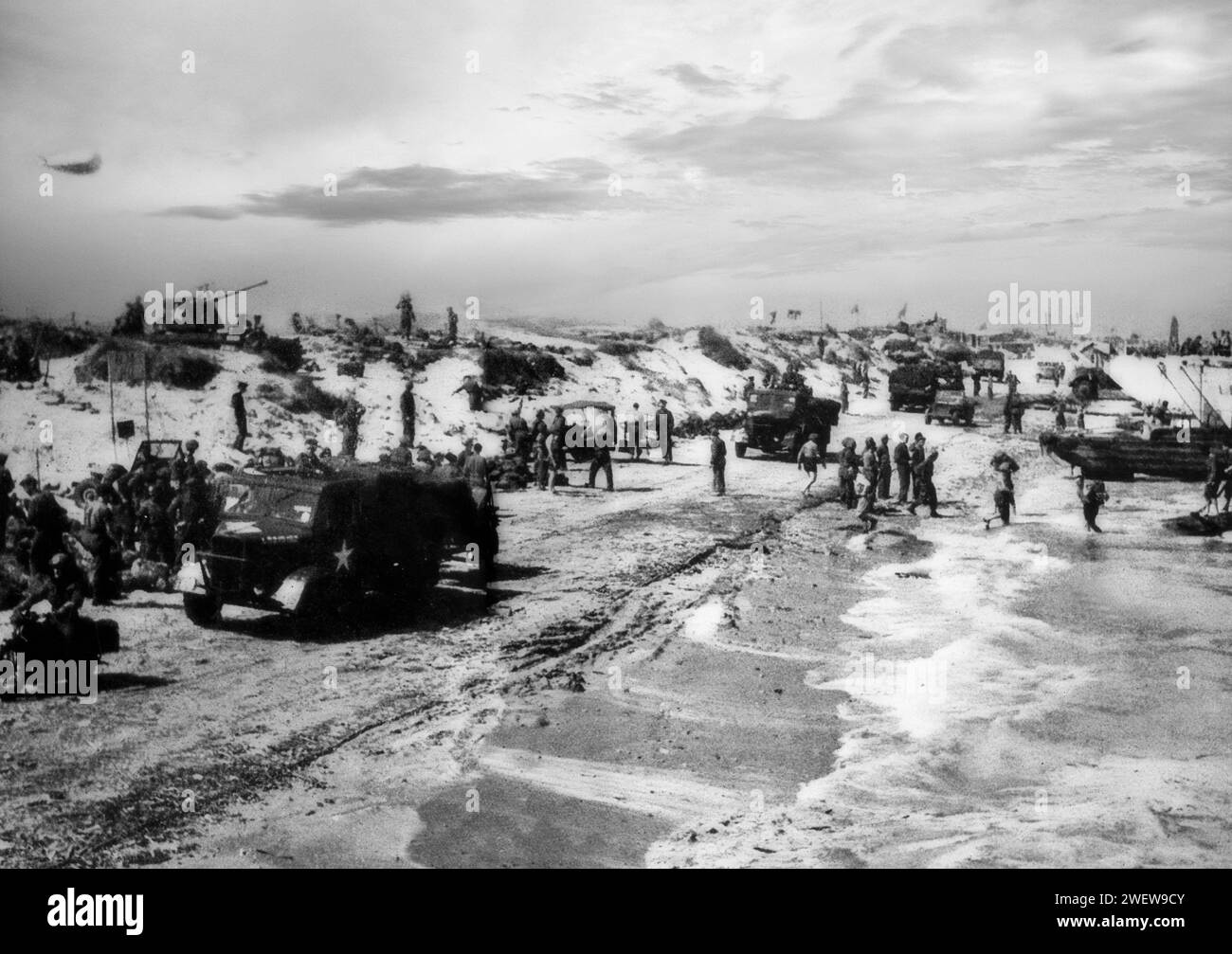 Dutch troops of the Princess Irene Brigade landing on the Normandy Beaches, France on D-Day, 6th June 1944 during the Second World War Stock Photohttps://www.alamy.com/image-license-details/?v=1https://www.alamy.com/dutch-troops-of-the-princess-irene-brigade-landing-on-the-normandy-beaches-france-on-d-day-6th-june-1944-during-the-second-world-war-image594313915.html
Dutch troops of the Princess Irene Brigade landing on the Normandy Beaches, France on D-Day, 6th June 1944 during the Second World War Stock Photohttps://www.alamy.com/image-license-details/?v=1https://www.alamy.com/dutch-troops-of-the-princess-irene-brigade-landing-on-the-normandy-beaches-france-on-d-day-6th-june-1944-during-the-second-world-war-image594313915.htmlRM2WEW9CY–Dutch troops of the Princess Irene Brigade landing on the Normandy Beaches, France on D-Day, 6th June 1944 during the Second World War
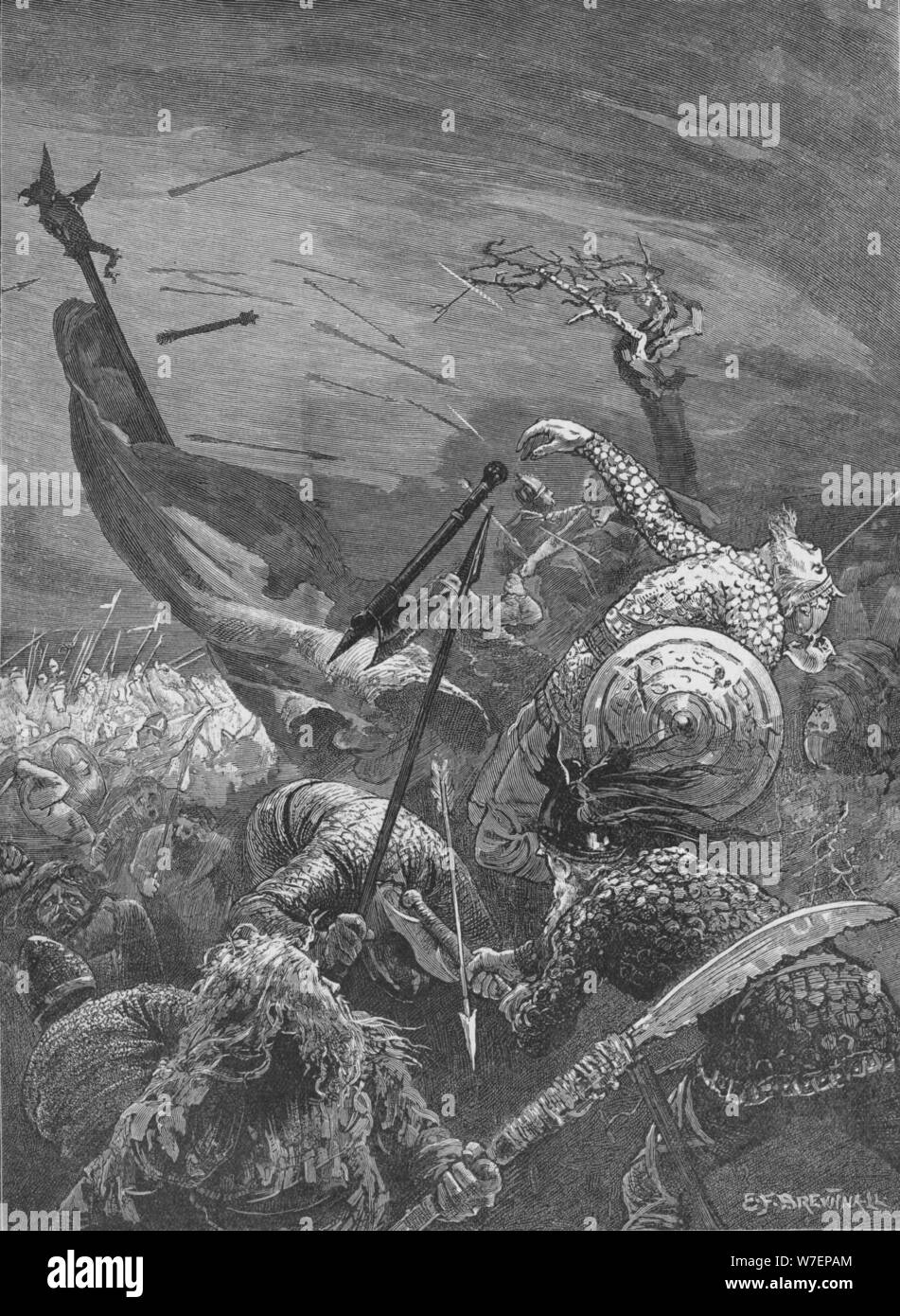 Death of King Harold at the Battle of Hastings, 1066 (1905). Artist: Unknown. Stock Photohttps://www.alamy.com/image-license-details/?v=1https://www.alamy.com/death-of-king-harold-at-the-battle-of-hastings-1066-1905-artist-unknown-image262782988.html
Death of King Harold at the Battle of Hastings, 1066 (1905). Artist: Unknown. Stock Photohttps://www.alamy.com/image-license-details/?v=1https://www.alamy.com/death-of-king-harold-at-the-battle-of-hastings-1066-1905-artist-unknown-image262782988.htmlRMW7EPAM–Death of King Harold at the Battle of Hastings, 1066 (1905). Artist: Unknown.
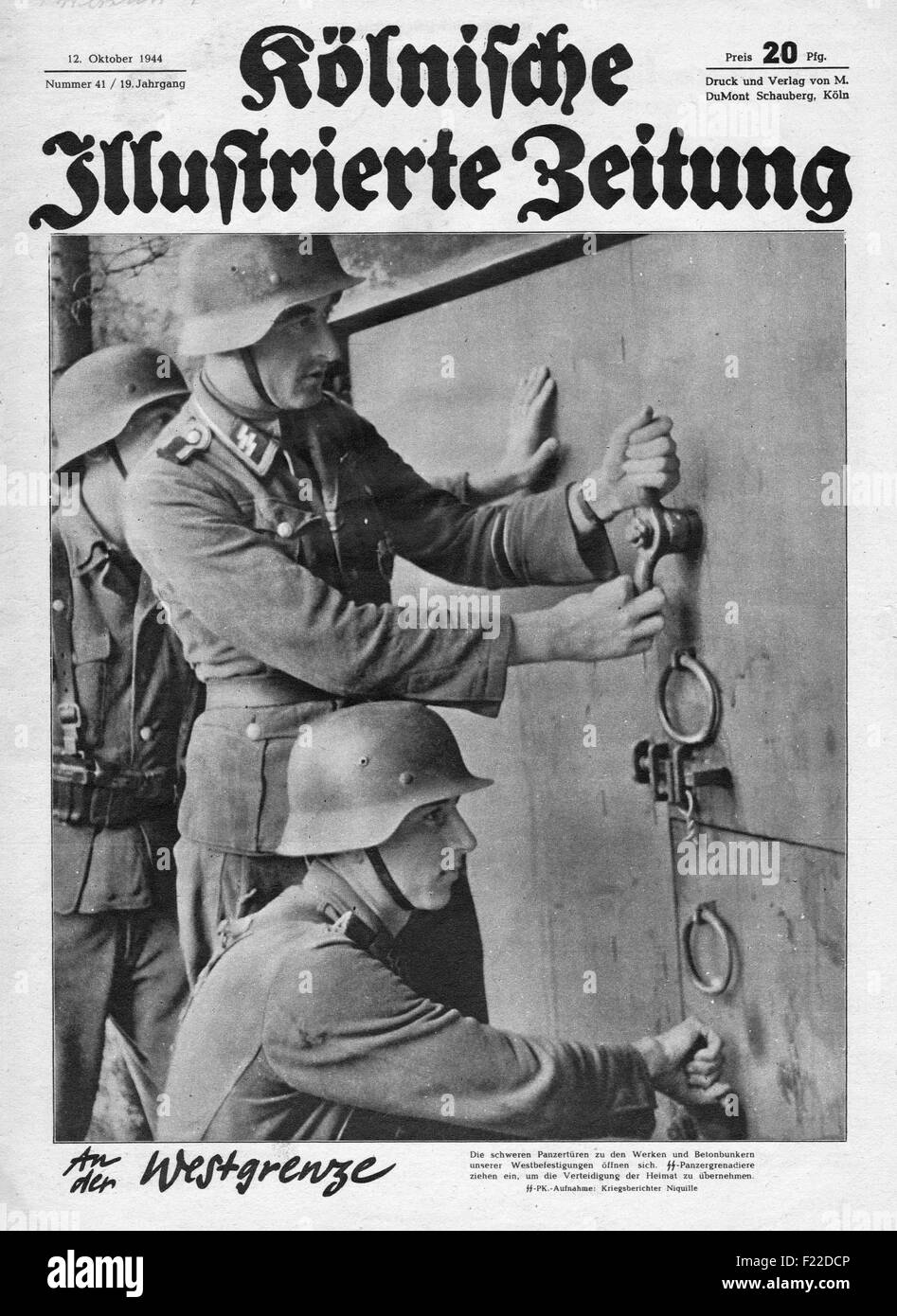 1944 Kolnischer Illustrierte Zeitung front page showing Waffen SS soldiers Stock Photohttps://www.alamy.com/image-license-details/?v=1https://www.alamy.com/stock-photo-1944-kolnischer-illustrierte-zeitung-front-page-showing-waffen-ss-87335606.html
1944 Kolnischer Illustrierte Zeitung front page showing Waffen SS soldiers Stock Photohttps://www.alamy.com/image-license-details/?v=1https://www.alamy.com/stock-photo-1944-kolnischer-illustrierte-zeitung-front-page-showing-waffen-ss-87335606.htmlRMF22DCP–1944 Kolnischer Illustrierte Zeitung front page showing Waffen SS soldiers
 U.S. Troops land at Normandy on D-Day. With the beach taken and barrage balloons deterring German aircraft, soldiers and Stock Photohttps://www.alamy.com/image-license-details/?v=1https://www.alamy.com/us-troops-land-at-normandy-on-d-day-with-the-beach-taken-and-barrage-image69739367.html
U.S. Troops land at Normandy on D-Day. With the beach taken and barrage balloons deterring German aircraft, soldiers and Stock Photohttps://www.alamy.com/image-license-details/?v=1https://www.alamy.com/us-troops-land-at-normandy-on-d-day-with-the-beach-taken-and-barrage-image69739367.htmlRME1CW7K–U.S. Troops land at Normandy on D-Day. With the beach taken and barrage balloons deterring German aircraft, soldiers and
 Ships carry Soldiers and equipment across the English Channel toward the coast of Normandy, D-Day, June 6, 1944. /d-day /d-day Stock Photohttps://www.alamy.com/image-license-details/?v=1https://www.alamy.com/stock-photo-ships-carry-soldiers-and-equipment-across-the-english-channel-toward-80262290.html
Ships carry Soldiers and equipment across the English Channel toward the coast of Normandy, D-Day, June 6, 1944. /d-day /d-day Stock Photohttps://www.alamy.com/image-license-details/?v=1https://www.alamy.com/stock-photo-ships-carry-soldiers-and-equipment-across-the-english-channel-toward-80262290.htmlRMEJG7AA–Ships carry Soldiers and equipment across the English Channel toward the coast of Normandy, D-Day, June 6, 1944. /d-day /d-day
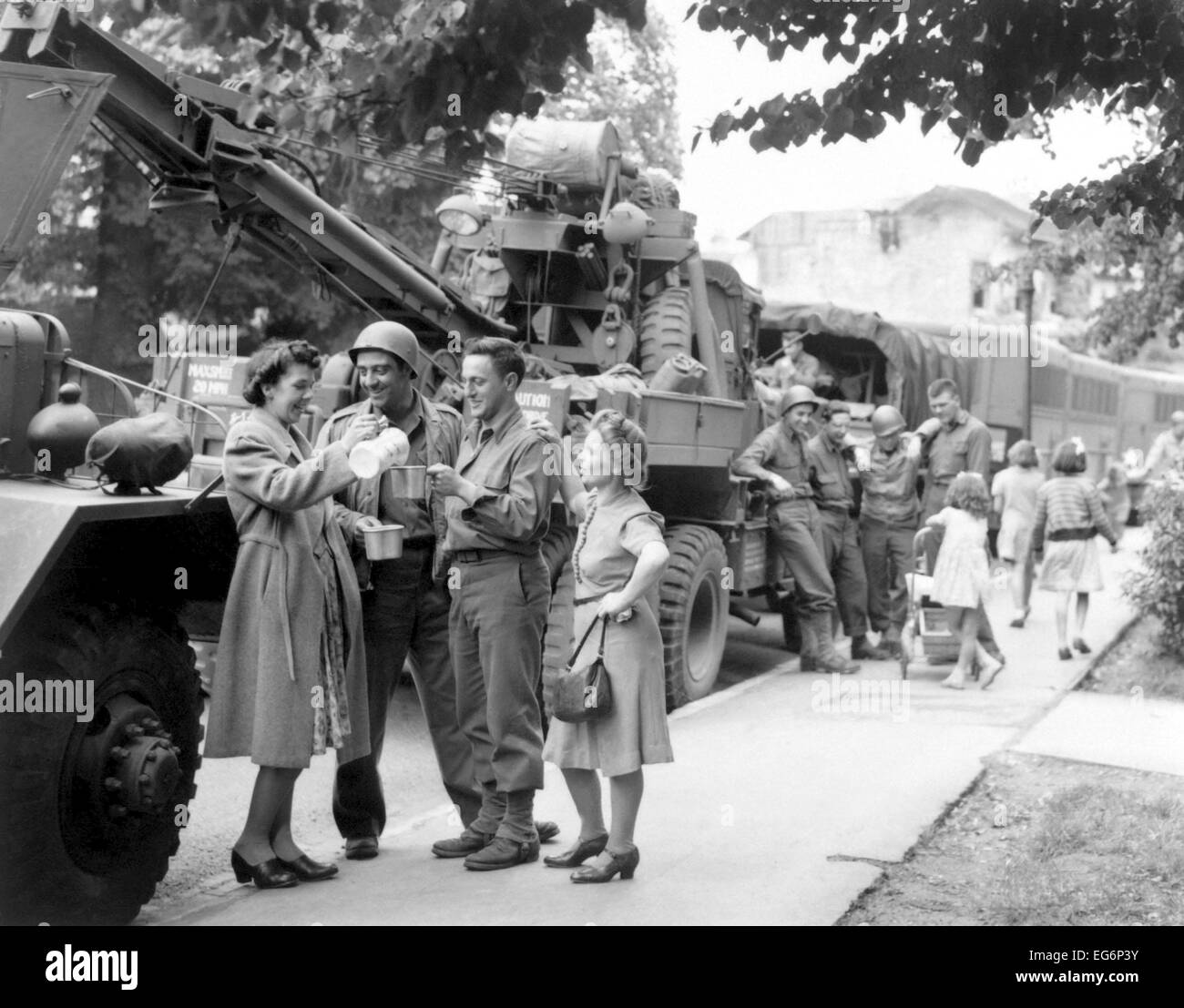 English townsfolk serve hot coffee to U.S. Army Ordnance men. They are awaiting their 'go' signal to join the ongoing invasion Stock Photohttps://www.alamy.com/image-license-details/?v=1https://www.alamy.com/stock-photo-english-townsfolk-serve-hot-coffee-to-us-army-ordnance-men-they-are-78825039.html
English townsfolk serve hot coffee to U.S. Army Ordnance men. They are awaiting their 'go' signal to join the ongoing invasion Stock Photohttps://www.alamy.com/image-license-details/?v=1https://www.alamy.com/stock-photo-english-townsfolk-serve-hot-coffee-to-us-army-ordnance-men-they-are-78825039.htmlRMEG6P3Y–English townsfolk serve hot coffee to U.S. Army Ordnance men. They are awaiting their 'go' signal to join the ongoing invasion
 Troop and equipment debarkation, Normandy, France, 6 June 1944? Artist: Unknown Stock Photohttps://www.alamy.com/image-license-details/?v=1https://www.alamy.com/troop-and-equipment-debarkation-normandy-france-6-june-1944-artist-unknown-image262758563.html
Troop and equipment debarkation, Normandy, France, 6 June 1944? Artist: Unknown Stock Photohttps://www.alamy.com/image-license-details/?v=1https://www.alamy.com/troop-and-equipment-debarkation-normandy-france-6-june-1944-artist-unknown-image262758563.htmlRMW7DK6B–Troop and equipment debarkation, Normandy, France, 6 June 1944? Artist: Unknown
![[ORIGINAL CAPTION] Men and equipment scattered about a command post on Red Beach, France. Some G.I. would not part with his English racer, so he brought it over (note right hand corner). 8 June 1944. Red Beach, France. Stock Photo [ORIGINAL CAPTION] Men and equipment scattered about a command post on Red Beach, France. Some G.I. would not part with his English racer, so he brought it over (note right hand corner). 8 June 1944. Red Beach, France. Stock Photo](https://c8.alamy.com/comp/2A5992N/original-caption-men-and-equipment-scattered-about-a-command-post-on-red-beach-france-some-gi-would-not-part-with-his-english-racer-so-he-brought-it-over-note-right-hand-corner-8-june-1944-red-beach-france-2A5992N.jpg) [ORIGINAL CAPTION] Men and equipment scattered about a command post on Red Beach, France. Some G.I. would not part with his English racer, so he brought it over (note right hand corner). 8 June 1944. Red Beach, France. Stock Photohttps://www.alamy.com/image-license-details/?v=1https://www.alamy.com/original-caption-men-and-equipment-scattered-about-a-command-post-on-red-beach-france-some-gi-would-not-part-with-his-english-racer-so-he-brought-it-over-note-right-hand-corner-8-june-1944-red-beach-france-image330274973.html
[ORIGINAL CAPTION] Men and equipment scattered about a command post on Red Beach, France. Some G.I. would not part with his English racer, so he brought it over (note right hand corner). 8 June 1944. Red Beach, France. Stock Photohttps://www.alamy.com/image-license-details/?v=1https://www.alamy.com/original-caption-men-and-equipment-scattered-about-a-command-post-on-red-beach-france-some-gi-would-not-part-with-his-english-racer-so-he-brought-it-over-note-right-hand-corner-8-june-1944-red-beach-france-image330274973.htmlRM2A5992N–[ORIGINAL CAPTION] Men and equipment scattered about a command post on Red Beach, France. Some G.I. would not part with his English racer, so he brought it over (note right hand corner). 8 June 1944. Red Beach, France.
 Photograph of Soldiers Crouching Behind the Bulwarks of a Coast Guard Landing Barge. French Coast Dead Ahead- Helmeted Yankee soldiers crouch, tightly packed, behind the bulwarks of a Coast Guard landing barge in the historic sweep across the English Channel to the shores of Normandy. Minutes later, they dashed up the beach under fire from the Nazi defenders. These Coast Guard barges rode back and forth through D-Day bringing wave of reinforcements to the beachhead. 1939 - 1967. Stock Photohttps://www.alamy.com/image-license-details/?v=1https://www.alamy.com/photograph-of-soldiers-crouching-behind-the-bulwarks-of-a-coast-guard-landing-barge-french-coast-dead-ahead-helmeted-yankee-soldiers-crouch-tightly-packed-behind-the-bulwarks-of-a-coast-guard-landing-barge-in-the-historic-sweep-across-the-english-channel-to-the-shores-of-normandy-minutes-later-they-dashed-up-the-beach-under-fire-from-the-nazi-defenders-these-coast-guard-barges-rode-back-and-forth-through-d-day-bringing-wave-of-reinforcements-to-the-beachhead-1939-1967-image508235439.html
Photograph of Soldiers Crouching Behind the Bulwarks of a Coast Guard Landing Barge. French Coast Dead Ahead- Helmeted Yankee soldiers crouch, tightly packed, behind the bulwarks of a Coast Guard landing barge in the historic sweep across the English Channel to the shores of Normandy. Minutes later, they dashed up the beach under fire from the Nazi defenders. These Coast Guard barges rode back and forth through D-Day bringing wave of reinforcements to the beachhead. 1939 - 1967. Stock Photohttps://www.alamy.com/image-license-details/?v=1https://www.alamy.com/photograph-of-soldiers-crouching-behind-the-bulwarks-of-a-coast-guard-landing-barge-french-coast-dead-ahead-helmeted-yankee-soldiers-crouch-tightly-packed-behind-the-bulwarks-of-a-coast-guard-landing-barge-in-the-historic-sweep-across-the-english-channel-to-the-shores-of-normandy-minutes-later-they-dashed-up-the-beach-under-fire-from-the-nazi-defenders-these-coast-guard-barges-rode-back-and-forth-through-d-day-bringing-wave-of-reinforcements-to-the-beachhead-1939-1967-image508235439.htmlRM2MET3DK–Photograph of Soldiers Crouching Behind the Bulwarks of a Coast Guard Landing Barge. French Coast Dead Ahead- Helmeted Yankee soldiers crouch, tightly packed, behind the bulwarks of a Coast Guard landing barge in the historic sweep across the English Channel to the shores of Normandy. Minutes later, they dashed up the beach under fire from the Nazi defenders. These Coast Guard barges rode back and forth through D-Day bringing wave of reinforcements to the beachhead. 1939 - 1967.
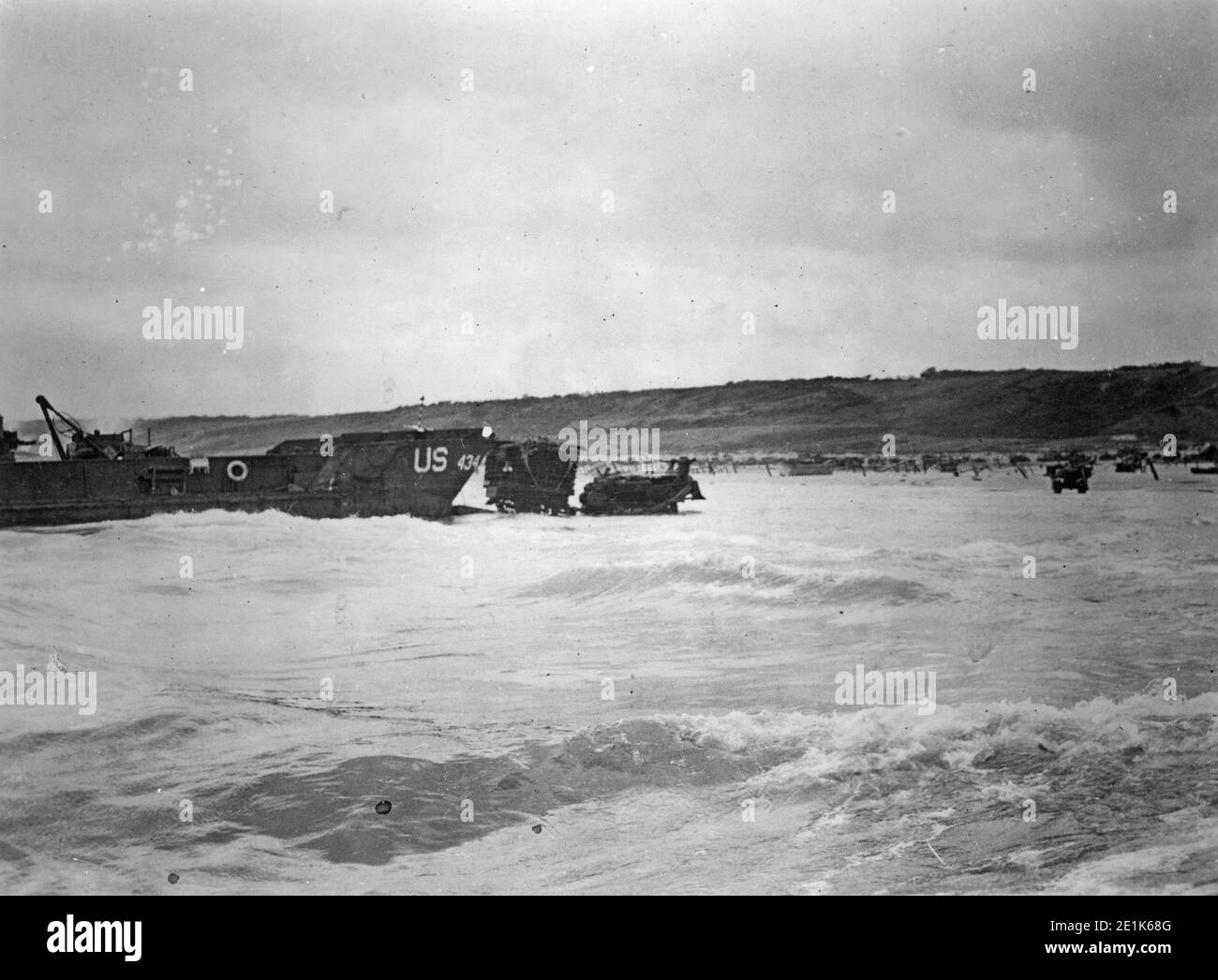 D-Day Landing of Allied Troops, June 1944 Stock Photohttps://www.alamy.com/image-license-details/?v=1https://www.alamy.com/d-day-landing-of-allied-troops-june-1944-image396875152.html
D-Day Landing of Allied Troops, June 1944 Stock Photohttps://www.alamy.com/image-license-details/?v=1https://www.alamy.com/d-day-landing-of-allied-troops-june-1944-image396875152.htmlRM2E1K68G–D-Day Landing of Allied Troops, June 1944
 Photograph of American Reinforcements Piling from a Coast Guard Landing Barge into the Surf on the French Coast Soldiers Crossing the English Channel aboard a Coast Guard 'Elsie' (LCI). It's Their Turn Now-American reinforcements, eager for their shot at the retreating Nazis in Normandy, pile from a Coast Guard landing barge into the surf on the French coast. Hardened for battle, they are going in to reinforce and replace the fighting units that secured the Norman beachhead and spread north toward Cherbourg. 1939 - 1967. Stock Photohttps://www.alamy.com/image-license-details/?v=1https://www.alamy.com/photograph-of-american-reinforcements-piling-from-a-coast-guard-landing-barge-into-the-surf-on-the-french-coast-soldiers-crossing-the-english-channel-aboard-a-coast-guard-elsie-lci-its-their-turn-now-american-reinforcements-eager-for-their-shot-at-the-retreating-nazis-in-normandy-pile-from-a-coast-guard-landing-barge-into-the-surf-on-the-french-coast-hardened-for-battle-they-are-going-in-to-reinforce-and-replace-the-fighting-units-that-secured-the-norman-beachhead-and-spread-north-toward-cherbourg-1939-1967-image508248119.html
Photograph of American Reinforcements Piling from a Coast Guard Landing Barge into the Surf on the French Coast Soldiers Crossing the English Channel aboard a Coast Guard 'Elsie' (LCI). It's Their Turn Now-American reinforcements, eager for their shot at the retreating Nazis in Normandy, pile from a Coast Guard landing barge into the surf on the French coast. Hardened for battle, they are going in to reinforce and replace the fighting units that secured the Norman beachhead and spread north toward Cherbourg. 1939 - 1967. Stock Photohttps://www.alamy.com/image-license-details/?v=1https://www.alamy.com/photograph-of-american-reinforcements-piling-from-a-coast-guard-landing-barge-into-the-surf-on-the-french-coast-soldiers-crossing-the-english-channel-aboard-a-coast-guard-elsie-lci-its-their-turn-now-american-reinforcements-eager-for-their-shot-at-the-retreating-nazis-in-normandy-pile-from-a-coast-guard-landing-barge-into-the-surf-on-the-french-coast-hardened-for-battle-they-are-going-in-to-reinforce-and-replace-the-fighting-units-that-secured-the-norman-beachhead-and-spread-north-toward-cherbourg-1939-1967-image508248119.htmlRM2METKJF–Photograph of American Reinforcements Piling from a Coast Guard Landing Barge into the Surf on the French Coast Soldiers Crossing the English Channel aboard a Coast Guard 'Elsie' (LCI). It's Their Turn Now-American reinforcements, eager for their shot at the retreating Nazis in Normandy, pile from a Coast Guard landing barge into the surf on the French coast. Hardened for battle, they are going in to reinforce and replace the fighting units that secured the Norman beachhead and spread north toward Cherbourg. 1939 - 1967.
 ENGLISH CHANNEL - 06 June 1944 - Torn by Nazi shells, the landing barge was sinking. American soldiers aboard appeared lost as the little craft settle Stock Photohttps://www.alamy.com/image-license-details/?v=1https://www.alamy.com/english-channel-06-june-1944-torn-by-nazi-shells-the-landing-barge-was-sinking-american-soldiers-aboard-appeared-lost-as-the-little-craft-settle-image607132273.html
ENGLISH CHANNEL - 06 June 1944 - Torn by Nazi shells, the landing barge was sinking. American soldiers aboard appeared lost as the little craft settle Stock Photohttps://www.alamy.com/image-license-details/?v=1https://www.alamy.com/english-channel-06-june-1944-torn-by-nazi-shells-the-landing-barge-was-sinking-american-soldiers-aboard-appeared-lost-as-the-little-craft-settle-image607132273.htmlRM2X7N7BD–ENGLISH CHANNEL - 06 June 1944 - Torn by Nazi shells, the landing barge was sinking. American soldiers aboard appeared lost as the little craft settle
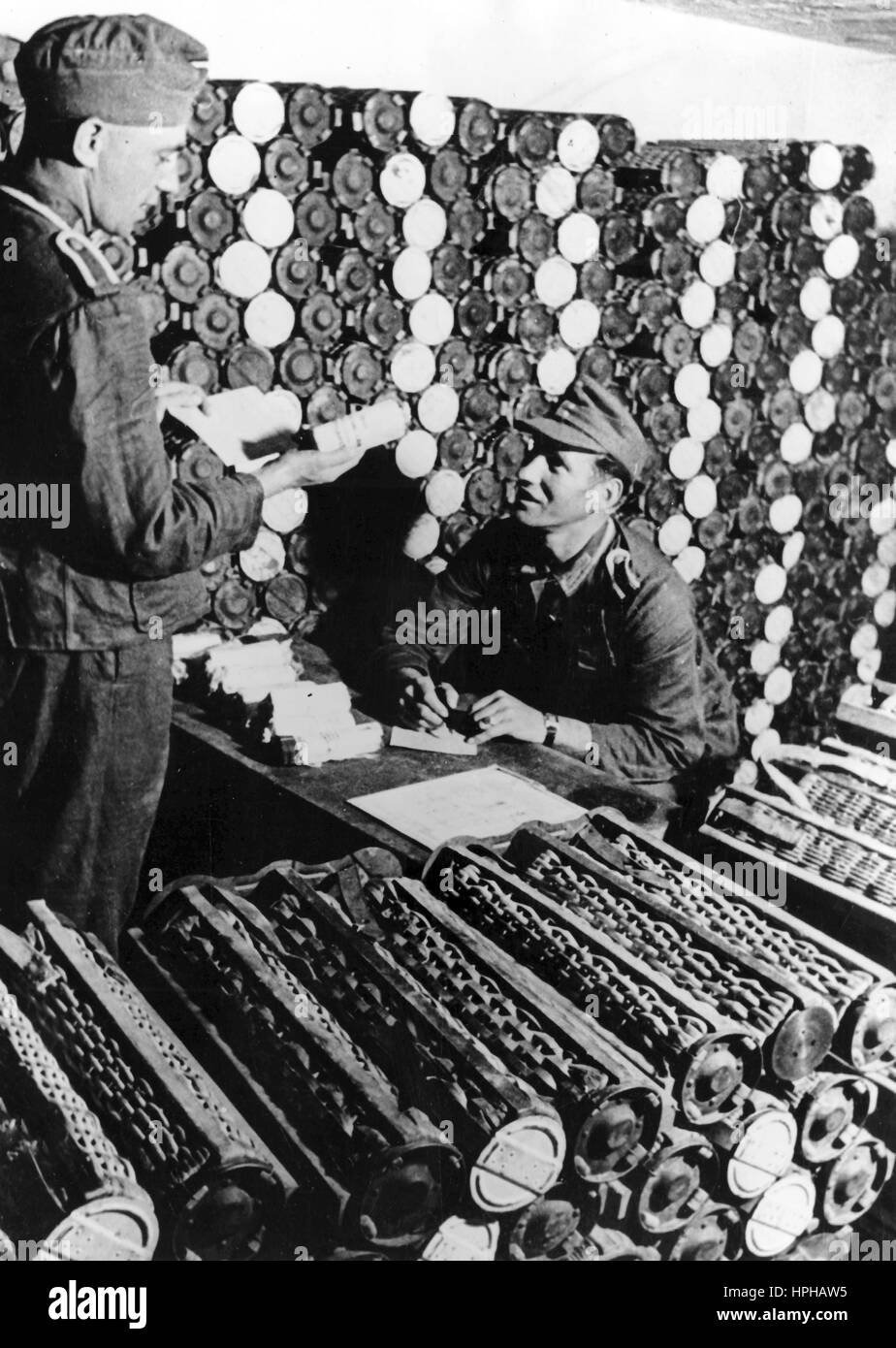 The Nazi propaganda image shows German Wehrmacht soldiers in a munitions bunker on the Atlantic Wall on the French Channel coast. Published in June 1944. A Nazi reporter has written on the reverse of the picture on 13.06.1944, 'Munitions bunker on the Channel coast. The supplies, which are being stockpiled in preparation for the invasion, are sufficient for many weeks of all round defence. The prevailing mood in these bunkers is a fighting one, ready for deployment.' Fotoarchiv für Zeitgeschichte - NO WIRE SERVICE - | usage worldwide Stock Photohttps://www.alamy.com/image-license-details/?v=1https://www.alamy.com/stock-photo-the-nazi-propaganda-image-shows-german-wehrmacht-soldiers-in-a-munitions-134376737.html
The Nazi propaganda image shows German Wehrmacht soldiers in a munitions bunker on the Atlantic Wall on the French Channel coast. Published in June 1944. A Nazi reporter has written on the reverse of the picture on 13.06.1944, 'Munitions bunker on the Channel coast. The supplies, which are being stockpiled in preparation for the invasion, are sufficient for many weeks of all round defence. The prevailing mood in these bunkers is a fighting one, ready for deployment.' Fotoarchiv für Zeitgeschichte - NO WIRE SERVICE - | usage worldwide Stock Photohttps://www.alamy.com/image-license-details/?v=1https://www.alamy.com/stock-photo-the-nazi-propaganda-image-shows-german-wehrmacht-soldiers-in-a-munitions-134376737.htmlRMHPHAW5–The Nazi propaganda image shows German Wehrmacht soldiers in a munitions bunker on the Atlantic Wall on the French Channel coast. Published in June 1944. A Nazi reporter has written on the reverse of the picture on 13.06.1944, 'Munitions bunker on the Channel coast. The supplies, which are being stockpiled in preparation for the invasion, are sufficient for many weeks of all round defence. The prevailing mood in these bunkers is a fighting one, ready for deployment.' Fotoarchiv für Zeitgeschichte - NO WIRE SERVICE - | usage worldwide
 battle of hastings, 1066 Stock Photohttps://www.alamy.com/image-license-details/?v=1https://www.alamy.com/battle-of-hastings-1066-image475233830.html
battle of hastings, 1066 Stock Photohttps://www.alamy.com/image-license-details/?v=1https://www.alamy.com/battle-of-hastings-1066-image475233830.htmlRM2JH4NGP–battle of hastings, 1066
 Death of King Harold at the Battle of Hastings, 1066 (1905). Artist: Unknown. Stock Photohttps://www.alamy.com/image-license-details/?v=1https://www.alamy.com/stock-photo-death-of-king-harold-at-the-battle-of-hastings-1066-1905-artist-unknown-135251610.html
Death of King Harold at the Battle of Hastings, 1066 (1905). Artist: Unknown. Stock Photohttps://www.alamy.com/image-license-details/?v=1https://www.alamy.com/stock-photo-death-of-king-harold-at-the-battle-of-hastings-1066-1905-artist-unknown-135251610.htmlRMHT16PJ–Death of King Harold at the Battle of Hastings, 1066 (1905). Artist: Unknown.
 The Nazi propaganda image shows a camouflaged German Wehrmacht position on the French Channel Coast. Published in June 1944. A Nazi reporter has written on the reverse, 'The invasion has begun. In the night on Tuesday, the British and American mustered the long-expected attack on the North French coast, on the orders of Moscow. The artillery points and bunkers of the Atlantic Wall, long ago armed and prepared for this moment, gave the aggressors a warm and (for the opposing side) unprofitable reception. Our picture shows one of the powerful gun bunkers on the Channel Coast.' Photo: Berliner Ve Stock Photohttps://www.alamy.com/image-license-details/?v=1https://www.alamy.com/stock-photo-the-nazi-propaganda-image-shows-a-camouflaged-german-wehrmacht-position-134376840.html
The Nazi propaganda image shows a camouflaged German Wehrmacht position on the French Channel Coast. Published in June 1944. A Nazi reporter has written on the reverse, 'The invasion has begun. In the night on Tuesday, the British and American mustered the long-expected attack on the North French coast, on the orders of Moscow. The artillery points and bunkers of the Atlantic Wall, long ago armed and prepared for this moment, gave the aggressors a warm and (for the opposing side) unprofitable reception. Our picture shows one of the powerful gun bunkers on the Channel Coast.' Photo: Berliner Ve Stock Photohttps://www.alamy.com/image-license-details/?v=1https://www.alamy.com/stock-photo-the-nazi-propaganda-image-shows-a-camouflaged-german-wehrmacht-position-134376840.htmlRMHPHB0T–The Nazi propaganda image shows a camouflaged German Wehrmacht position on the French Channel Coast. Published in June 1944. A Nazi reporter has written on the reverse, 'The invasion has begun. In the night on Tuesday, the British and American mustered the long-expected attack on the North French coast, on the orders of Moscow. The artillery points and bunkers of the Atlantic Wall, long ago armed and prepared for this moment, gave the aggressors a warm and (for the opposing side) unprofitable reception. Our picture shows one of the powerful gun bunkers on the Channel Coast.' Photo: Berliner Ve
 The Bayeux Tapestry, an embroidered cloth showing the events leading up to the Norman conquest of England, Stock Photohttps://www.alamy.com/image-license-details/?v=1https://www.alamy.com/the-bayeux-tapestry-an-embroidered-cloth-showing-the-events-leading-image64895159.html
The Bayeux Tapestry, an embroidered cloth showing the events leading up to the Norman conquest of England, Stock Photohttps://www.alamy.com/image-license-details/?v=1https://www.alamy.com/the-bayeux-tapestry-an-embroidered-cloth-showing-the-events-leading-image64895159.htmlRMDNG6C7–The Bayeux Tapestry, an embroidered cloth showing the events leading up to the Norman conquest of England,
 glider gliders Dragons teeth Pegasus bridge water river France French forces battle bridge attacked German troops commanders landed land war battle Stock Photohttps://www.alamy.com/image-license-details/?v=1https://www.alamy.com/glider-gliders-dragons-teeth-pegasus-bridge-water-river-france-french-forces-battle-bridge-attacked-german-troops-commanders-landed-land-war-battle-image618694063.html
glider gliders Dragons teeth Pegasus bridge water river France French forces battle bridge attacked German troops commanders landed land war battle Stock Photohttps://www.alamy.com/image-license-details/?v=1https://www.alamy.com/glider-gliders-dragons-teeth-pegasus-bridge-water-river-france-french-forces-battle-bridge-attacked-german-troops-commanders-landed-land-war-battle-image618694063.htmlRF2XXFXGF–glider gliders Dragons teeth Pegasus bridge water river France French forces battle bridge attacked German troops commanders landed land war battle
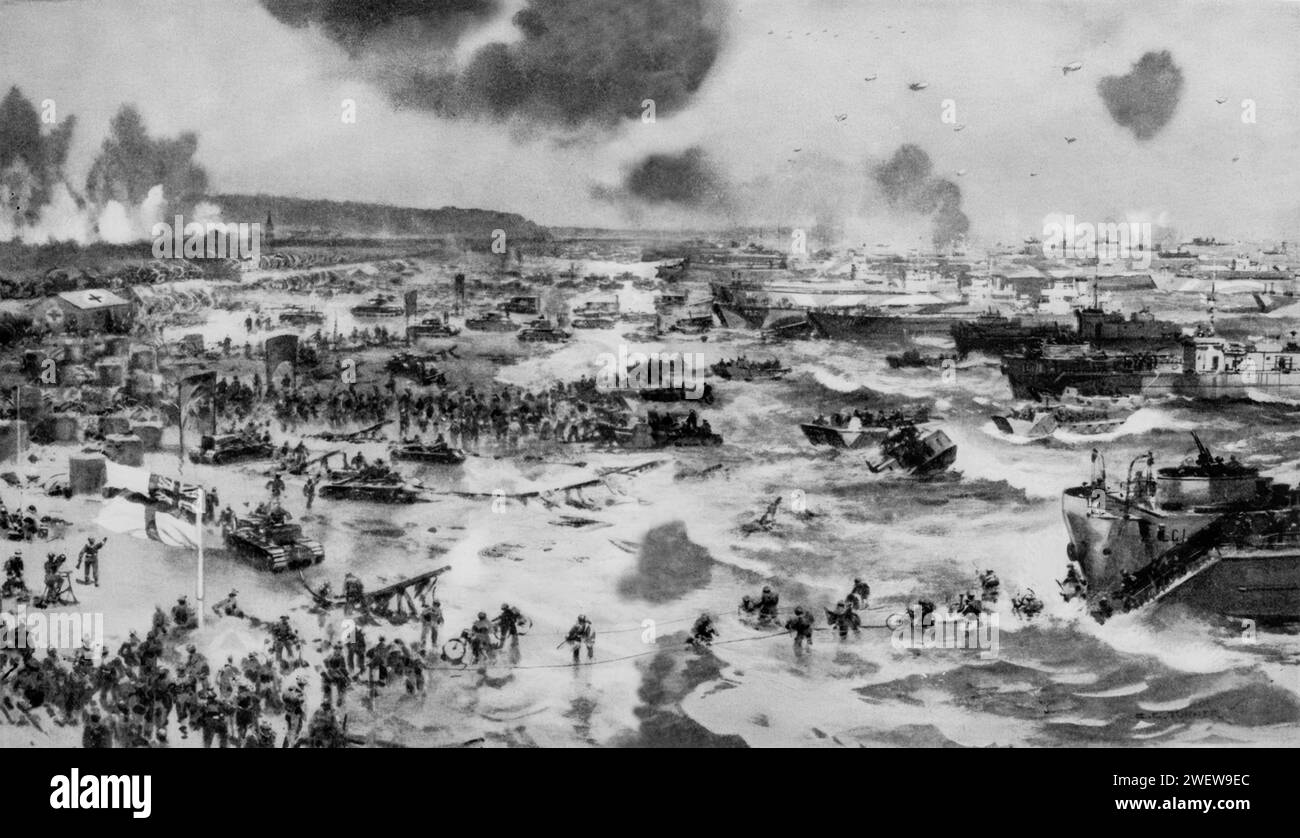 An illustration by Charles E. Turner the mass Allied landings on the Normandy Beaches, France on D-Day, 6th June 1944 during the Second World War. Stock Photohttps://www.alamy.com/image-license-details/?v=1https://www.alamy.com/an-illustration-by-charles-e-turner-the-mass-allied-landings-on-the-normandy-beaches-france-on-d-day-6th-june-1944-during-the-second-world-war-image594313956.html
An illustration by Charles E. Turner the mass Allied landings on the Normandy Beaches, France on D-Day, 6th June 1944 during the Second World War. Stock Photohttps://www.alamy.com/image-license-details/?v=1https://www.alamy.com/an-illustration-by-charles-e-turner-the-mass-allied-landings-on-the-normandy-beaches-france-on-d-day-6th-june-1944-during-the-second-world-war-image594313956.htmlRM2WEW9EC–An illustration by Charles E. Turner the mass Allied landings on the Normandy Beaches, France on D-Day, 6th June 1944 during the Second World War.
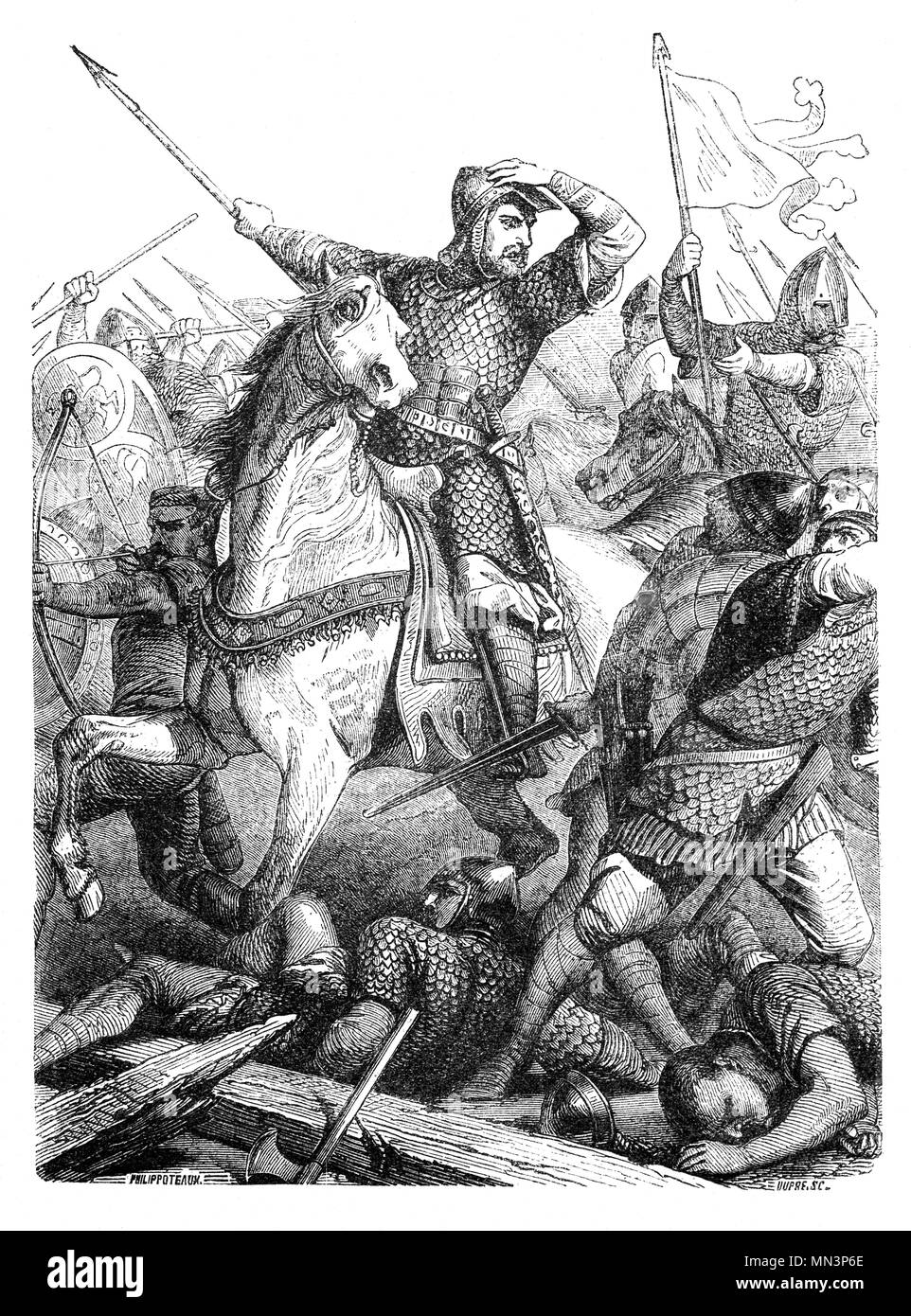 A scene from the Battle of Hastings fought on 14 October 1066 between the Norman-French army of William, the Duke of Normandy, and an English army under the Anglo-Saxon King Harold Godwinson, beginning the Norman conquest of England. It took place approximately 7 miles (11 kilometres) northwest of Hastings, close to the present-day town of Battle, East Sussex, and was a decisive Norman victory. Stock Photohttps://www.alamy.com/image-license-details/?v=1https://www.alamy.com/a-scene-from-the-battle-of-hastings-fought-on-14-october-1066-between-the-norman-french-army-of-william-the-duke-of-normandy-and-an-english-army-under-the-anglo-saxon-king-harold-godwinson-beginning-the-norman-conquest-of-england-it-took-place-approximately-7-miles-11-kilometres-northwest-of-hastings-close-to-the-present-day-town-of-battle-east-sussex-and-was-a-decisive-norman-victory-image185094742.html
A scene from the Battle of Hastings fought on 14 October 1066 between the Norman-French army of William, the Duke of Normandy, and an English army under the Anglo-Saxon King Harold Godwinson, beginning the Norman conquest of England. It took place approximately 7 miles (11 kilometres) northwest of Hastings, close to the present-day town of Battle, East Sussex, and was a decisive Norman victory. Stock Photohttps://www.alamy.com/image-license-details/?v=1https://www.alamy.com/a-scene-from-the-battle-of-hastings-fought-on-14-october-1066-between-the-norman-french-army-of-william-the-duke-of-normandy-and-an-english-army-under-the-anglo-saxon-king-harold-godwinson-beginning-the-norman-conquest-of-england-it-took-place-approximately-7-miles-11-kilometres-northwest-of-hastings-close-to-the-present-day-town-of-battle-east-sussex-and-was-a-decisive-norman-victory-image185094742.htmlRMMN3P6E–A scene from the Battle of Hastings fought on 14 October 1066 between the Norman-French army of William, the Duke of Normandy, and an English army under the Anglo-Saxon King Harold Godwinson, beginning the Norman conquest of England. It took place approximately 7 miles (11 kilometres) northwest of Hastings, close to the present-day town of Battle, East Sussex, and was a decisive Norman victory.
 U.S. soldiers of the 4th U.S. Infantry in a landing craft during the D-Day invasion of Normandy. The gunner is at the stern of Stock Photohttps://www.alamy.com/image-license-details/?v=1https://www.alamy.com/us-soldiers-of-the-4th-us-infantry-in-a-landing-craft-during-the-d-image69739360.html
U.S. soldiers of the 4th U.S. Infantry in a landing craft during the D-Day invasion of Normandy. The gunner is at the stern of Stock Photohttps://www.alamy.com/image-license-details/?v=1https://www.alamy.com/us-soldiers-of-the-4th-us-infantry-in-a-landing-craft-during-the-d-image69739360.htmlRME1CW7C–U.S. soldiers of the 4th U.S. Infantry in a landing craft during the D-Day invasion of Normandy. The gunner is at the stern of
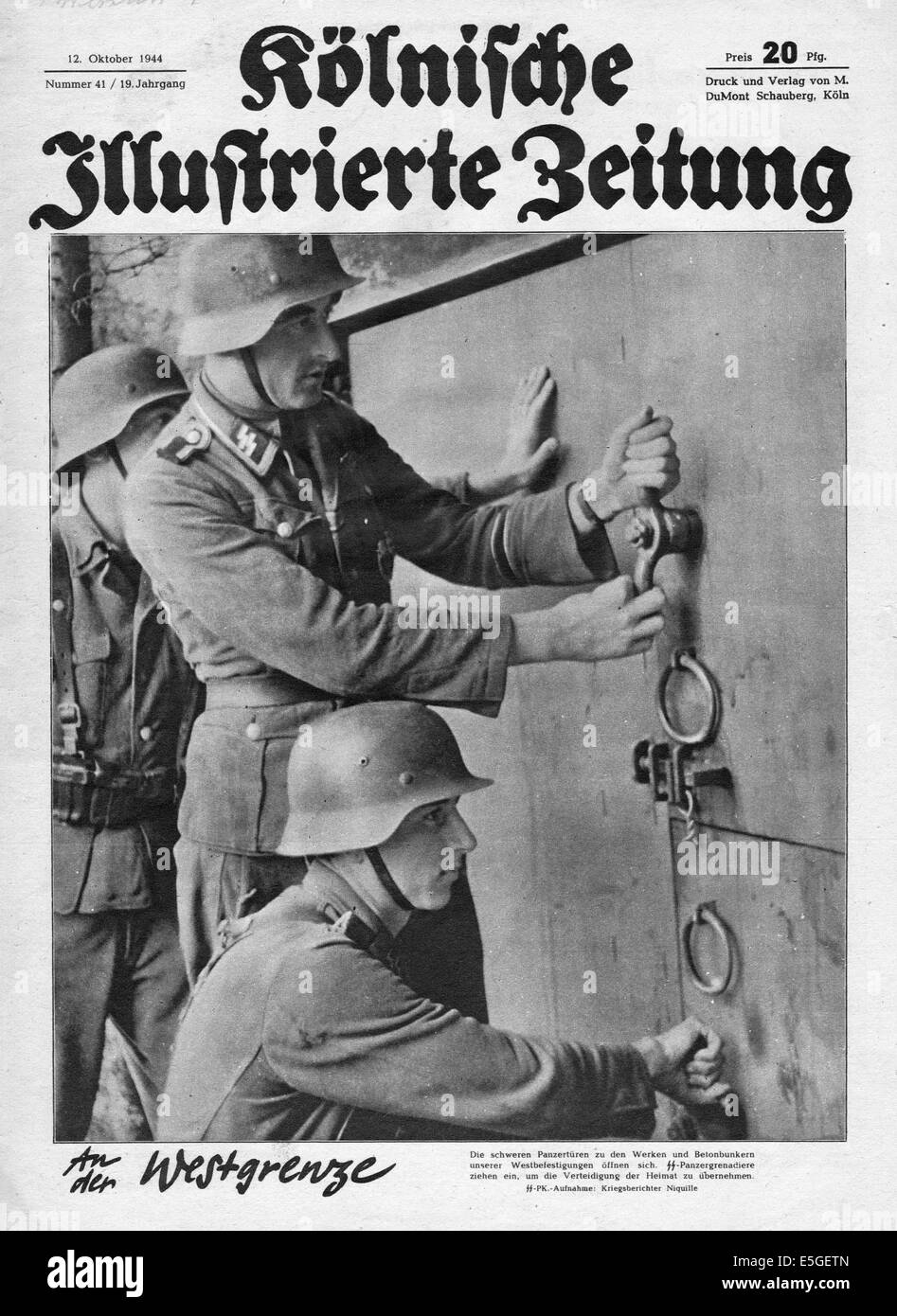 1944 Kolnischer Illustrierte Zeitung front page showing Waffen SS soldiers Stock Photohttps://www.alamy.com/image-license-details/?v=1https://www.alamy.com/stock-photo-1944-kolnischer-illustrierte-zeitung-front-page-showing-waffen-ss-72277653.html
1944 Kolnischer Illustrierte Zeitung front page showing Waffen SS soldiers Stock Photohttps://www.alamy.com/image-license-details/?v=1https://www.alamy.com/stock-photo-1944-kolnischer-illustrierte-zeitung-front-page-showing-waffen-ss-72277653.htmlRME5GETN–1944 Kolnischer Illustrierte Zeitung front page showing Waffen SS soldiers
 D-DAY, American Paratroopers flying over the English Channel enroute to the Normandy Invasion, 06/06/44. Courtesy: CSU Archives Stock Photohttps://www.alamy.com/image-license-details/?v=1https://www.alamy.com/stock-photo-d-day-american-paratroopers-flying-over-the-english-channel-enroute-50011851.html
D-DAY, American Paratroopers flying over the English Channel enroute to the Normandy Invasion, 06/06/44. Courtesy: CSU Archives Stock Photohttps://www.alamy.com/image-license-details/?v=1https://www.alamy.com/stock-photo-d-day-american-paratroopers-flying-over-the-english-channel-enroute-50011851.htmlRMCWA6HF–D-DAY, American Paratroopers flying over the English Channel enroute to the Normandy Invasion, 06/06/44. Courtesy: CSU Archives
![[ORIGINAL CAPTION] Men and equipment scattered about a command post on Red Beach, France. Some G.I. would not part with his English racer, so he brought it over (note right hand corner). 8 June 1944. Red Beach, France. Stock Photo [ORIGINAL CAPTION] Men and equipment scattered about a command post on Red Beach, France. Some G.I. would not part with his English racer, so he brought it over (note right hand corner). 8 June 1944. Red Beach, France. Stock Photo](https://c8.alamy.com/comp/W2GWA1/original-caption-men-and-equipment-scattered-about-a-command-post-on-red-beach-france-some-gi-would-not-part-with-his-english-racer-so-he-brought-it-over-note-right-hand-corner-8-june-1944-red-beach-france-W2GWA1.jpg) [ORIGINAL CAPTION] Men and equipment scattered about a command post on Red Beach, France. Some G.I. would not part with his English racer, so he brought it over (note right hand corner). 8 June 1944. Red Beach, France. Stock Photohttps://www.alamy.com/image-license-details/?v=1https://www.alamy.com/original-caption-men-and-equipment-scattered-about-a-command-post-on-red-beach-france-some-gi-would-not-part-with-his-english-racer-so-he-brought-it-over-note-right-hand-corner-8-june-1944-red-beach-france-image259755945.html
[ORIGINAL CAPTION] Men and equipment scattered about a command post on Red Beach, France. Some G.I. would not part with his English racer, so he brought it over (note right hand corner). 8 June 1944. Red Beach, France. Stock Photohttps://www.alamy.com/image-license-details/?v=1https://www.alamy.com/original-caption-men-and-equipment-scattered-about-a-command-post-on-red-beach-france-some-gi-would-not-part-with-his-english-racer-so-he-brought-it-over-note-right-hand-corner-8-june-1944-red-beach-france-image259755945.htmlRMW2GWA1–[ORIGINAL CAPTION] Men and equipment scattered about a command post on Red Beach, France. Some G.I. would not part with his English racer, so he brought it over (note right hand corner). 8 June 1944. Red Beach, France.
 ENGLISH CHANNEL - 06 June 1944 - A casualty of the heavy Nazi fire against the D-Day invasion fleet, a US Coast Guard LCI (Landing Craft Infantry) loa Stock Photohttps://www.alamy.com/image-license-details/?v=1https://www.alamy.com/english-channel-06-june-1944-a-casualty-of-the-heavy-nazi-fire-against-the-d-day-invasion-fleet-a-us-coast-guard-lci-landing-craft-infantry-loa-image607132170.html
ENGLISH CHANNEL - 06 June 1944 - A casualty of the heavy Nazi fire against the D-Day invasion fleet, a US Coast Guard LCI (Landing Craft Infantry) loa Stock Photohttps://www.alamy.com/image-license-details/?v=1https://www.alamy.com/english-channel-06-june-1944-a-casualty-of-the-heavy-nazi-fire-against-the-d-day-invasion-fleet-a-us-coast-guard-lci-landing-craft-infantry-loa-image607132170.htmlRM2X7N77P–ENGLISH CHANNEL - 06 June 1944 - A casualty of the heavy Nazi fire against the D-Day invasion fleet, a US Coast Guard LCI (Landing Craft Infantry) loa
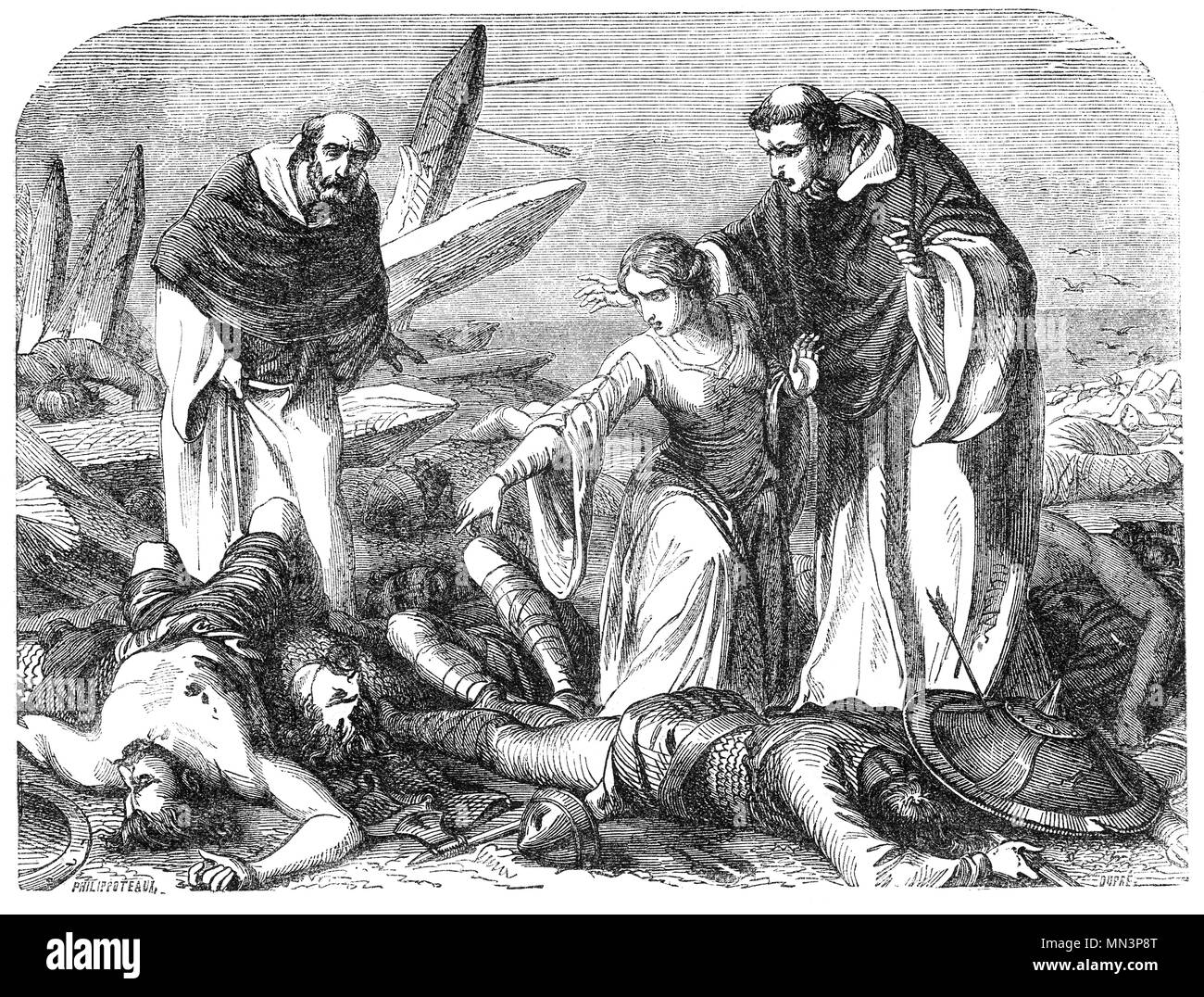 The discovery of the body of King Harold by his consort, Edith the Fair, after the Battle of Hastings fought on 14 October 1066 between the Norman-French army of William, the Duke of Normandy, and an English army under the Anglo-Saxon King Harold Godwinson, beginning the Norman conquest of England. It took place approximately 7 miles (11 kilometres) northwest of Hastings, close to the present-day town of Battle, East Sussex, and was a decisive Norman victory. Stock Photohttps://www.alamy.com/image-license-details/?v=1https://www.alamy.com/the-discovery-of-the-body-of-king-harold-by-his-consort-edith-the-fair-after-the-battle-of-hastings-fought-on-14-october-1066-between-the-norman-french-army-of-william-the-duke-of-normandy-and-an-english-army-under-the-anglo-saxon-king-harold-godwinson-beginning-the-norman-conquest-of-england-it-took-place-approximately-7-miles-11-kilometres-northwest-of-hastings-close-to-the-present-day-town-of-battle-east-sussex-and-was-a-decisive-norman-victory-image185094808.html
The discovery of the body of King Harold by his consort, Edith the Fair, after the Battle of Hastings fought on 14 October 1066 between the Norman-French army of William, the Duke of Normandy, and an English army under the Anglo-Saxon King Harold Godwinson, beginning the Norman conquest of England. It took place approximately 7 miles (11 kilometres) northwest of Hastings, close to the present-day town of Battle, East Sussex, and was a decisive Norman victory. Stock Photohttps://www.alamy.com/image-license-details/?v=1https://www.alamy.com/the-discovery-of-the-body-of-king-harold-by-his-consort-edith-the-fair-after-the-battle-of-hastings-fought-on-14-october-1066-between-the-norman-french-army-of-william-the-duke-of-normandy-and-an-english-army-under-the-anglo-saxon-king-harold-godwinson-beginning-the-norman-conquest-of-england-it-took-place-approximately-7-miles-11-kilometres-northwest-of-hastings-close-to-the-present-day-town-of-battle-east-sussex-and-was-a-decisive-norman-victory-image185094808.htmlRMMN3P8T–The discovery of the body of King Harold by his consort, Edith the Fair, after the Battle of Hastings fought on 14 October 1066 between the Norman-French army of William, the Duke of Normandy, and an English army under the Anglo-Saxon King Harold Godwinson, beginning the Norman conquest of England. It took place approximately 7 miles (11 kilometres) northwest of Hastings, close to the present-day town of Battle, East Sussex, and was a decisive Norman victory.
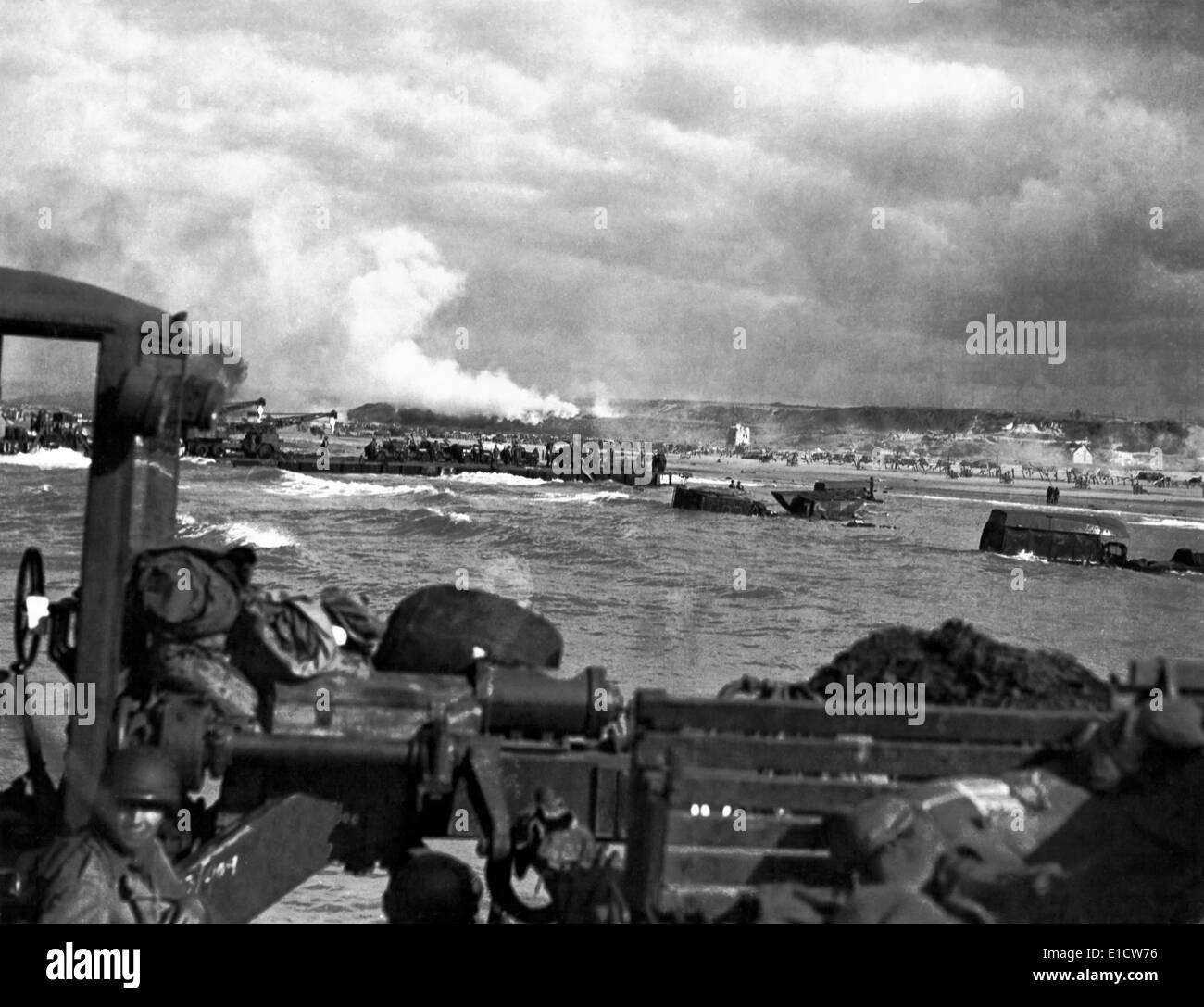 U.S. landing craft approaching Omaha Beach in Normandy beach on Dec. 6, 1944. Soldiers are standing on ships decks, indicating Stock Photohttps://www.alamy.com/image-license-details/?v=1https://www.alamy.com/us-landing-craft-approaching-omaha-beach-in-normandy-beach-on-dec-image69739354.html
U.S. landing craft approaching Omaha Beach in Normandy beach on Dec. 6, 1944. Soldiers are standing on ships decks, indicating Stock Photohttps://www.alamy.com/image-license-details/?v=1https://www.alamy.com/us-landing-craft-approaching-omaha-beach-in-normandy-beach-on-dec-image69739354.htmlRME1CW76–U.S. landing craft approaching Omaha Beach in Normandy beach on Dec. 6, 1944. Soldiers are standing on ships decks, indicating
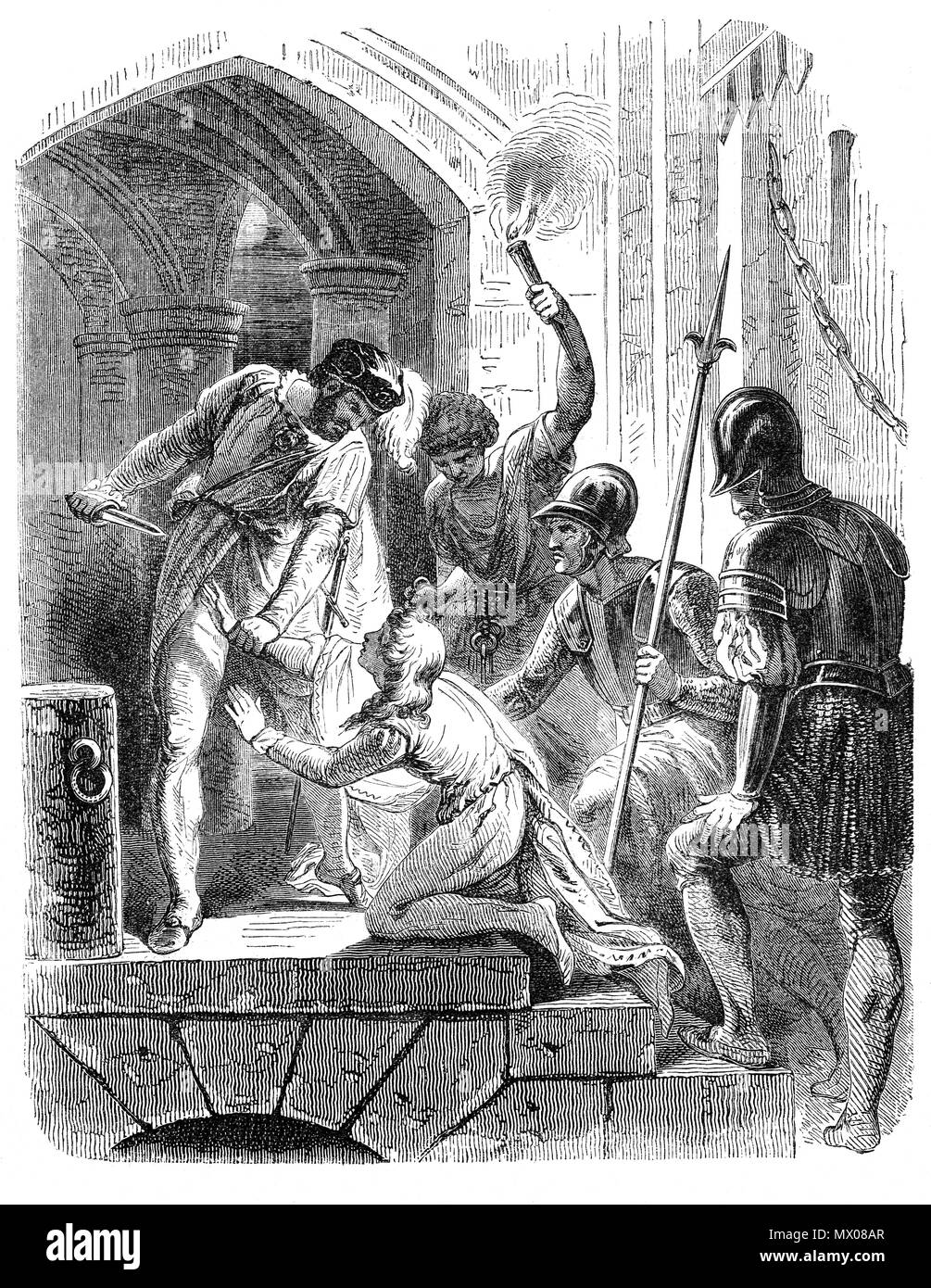 Prince Arthur (1187 – probably 1203) was 4th Earl of Richmond and Duke of Brittany between 1196 and 1203. He was the posthumous son of Geoffrey II, the son of King Henry II. In 1190 Arthur was designated heir to the throne of England and its French territory by his uncle, KingRichard I, the intent being that Arthur would succeed Richard in preference to Richard's younger brother John. Nothing is recorded of Arthur after his incarceration in Rouen Castle in 1203, and while his precise fate is unknown, it is generally believed he was killed by John and tossed into the River Seine. Stock Photohttps://www.alamy.com/image-license-details/?v=1https://www.alamy.com/prince-arthur-1187-probably-1203-was-4th-earl-of-richmond-and-duke-of-brittany-between-1196-and-1203-he-was-the-posthumous-son-of-geoffrey-ii-the-son-of-king-henry-ii-in-1190-arthur-was-designated-heir-to-the-throne-of-england-and-its-french-territory-by-his-uncle-kingrichard-i-the-intent-being-that-arthur-would-succeed-richard-in-preference-to-richards-younger-brother-john-nothing-is-recorded-of-arthur-after-his-incarceration-in-rouen-castle-in-1203-and-while-his-precise-fate-is-unknown-it-is-generally-believed-he-was-killed-by-john-and-tossed-into-the-river-seine-image188091311.html
Prince Arthur (1187 – probably 1203) was 4th Earl of Richmond and Duke of Brittany between 1196 and 1203. He was the posthumous son of Geoffrey II, the son of King Henry II. In 1190 Arthur was designated heir to the throne of England and its French territory by his uncle, KingRichard I, the intent being that Arthur would succeed Richard in preference to Richard's younger brother John. Nothing is recorded of Arthur after his incarceration in Rouen Castle in 1203, and while his precise fate is unknown, it is generally believed he was killed by John and tossed into the River Seine. Stock Photohttps://www.alamy.com/image-license-details/?v=1https://www.alamy.com/prince-arthur-1187-probably-1203-was-4th-earl-of-richmond-and-duke-of-brittany-between-1196-and-1203-he-was-the-posthumous-son-of-geoffrey-ii-the-son-of-king-henry-ii-in-1190-arthur-was-designated-heir-to-the-throne-of-england-and-its-french-territory-by-his-uncle-kingrichard-i-the-intent-being-that-arthur-would-succeed-richard-in-preference-to-richards-younger-brother-john-nothing-is-recorded-of-arthur-after-his-incarceration-in-rouen-castle-in-1203-and-while-his-precise-fate-is-unknown-it-is-generally-believed-he-was-killed-by-john-and-tossed-into-the-river-seine-image188091311.htmlRMMX08AR–Prince Arthur (1187 – probably 1203) was 4th Earl of Richmond and Duke of Brittany between 1196 and 1203. He was the posthumous son of Geoffrey II, the son of King Henry II. In 1190 Arthur was designated heir to the throne of England and its French territory by his uncle, KingRichard I, the intent being that Arthur would succeed Richard in preference to Richard's younger brother John. Nothing is recorded of Arthur after his incarceration in Rouen Castle in 1203, and while his precise fate is unknown, it is generally believed he was killed by John and tossed into the River Seine.
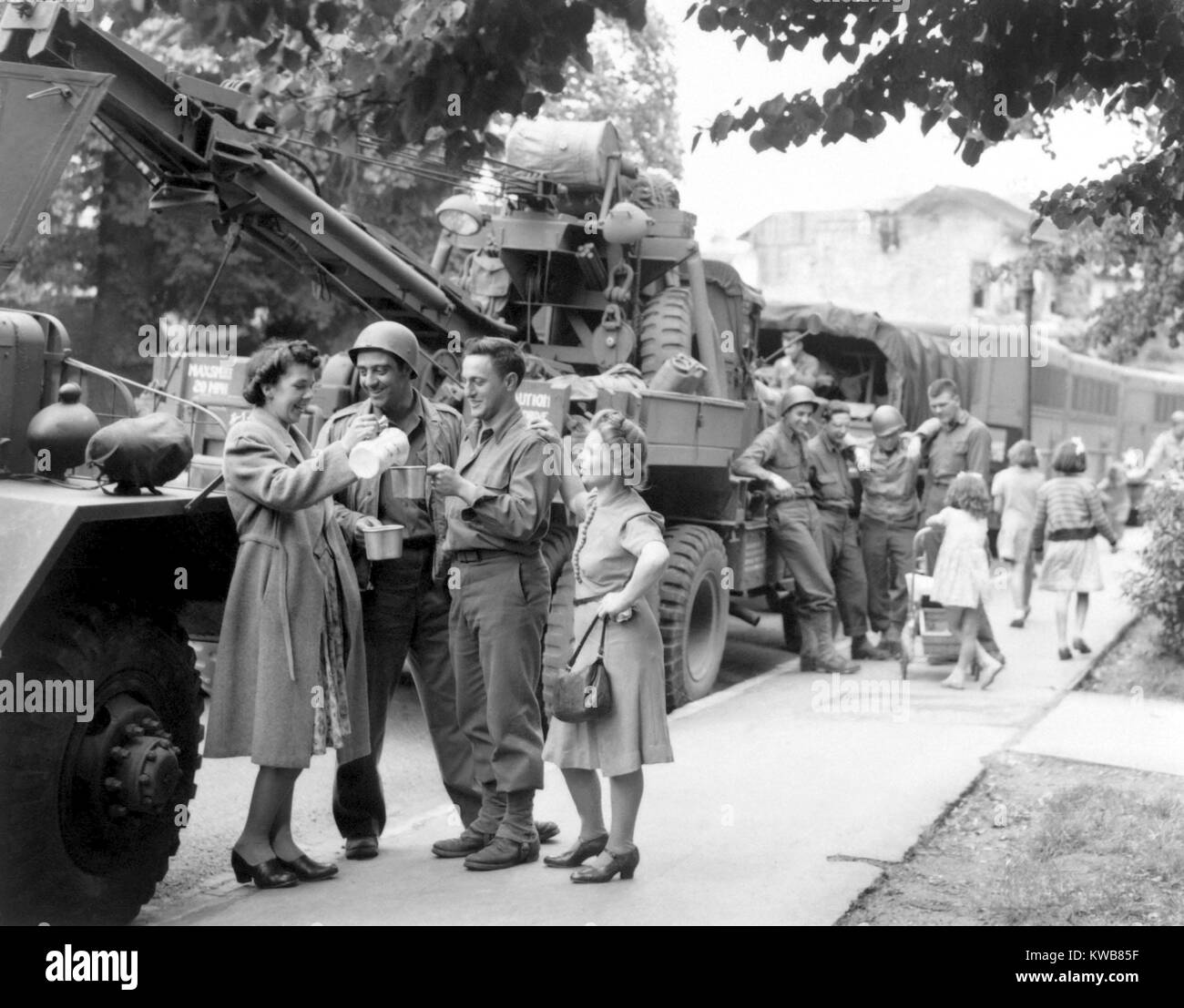 English townsfolk serve hot coffee to U.S. Army Ordnance men. They are awaiting their 'go' signal to join the ongoing invasion of France. July 24, 1944. World War 2. (BSLOC 2014 10 64) Stock Photohttps://www.alamy.com/image-license-details/?v=1https://www.alamy.com/stock-photo-english-townsfolk-serve-hot-coffee-to-us-army-ordnance-men-they-are-170507611.html
English townsfolk serve hot coffee to U.S. Army Ordnance men. They are awaiting their 'go' signal to join the ongoing invasion of France. July 24, 1944. World War 2. (BSLOC 2014 10 64) Stock Photohttps://www.alamy.com/image-license-details/?v=1https://www.alamy.com/stock-photo-english-townsfolk-serve-hot-coffee-to-us-army-ordnance-men-they-are-170507611.htmlRMKWB85F–English townsfolk serve hot coffee to U.S. Army Ordnance men. They are awaiting their 'go' signal to join the ongoing invasion of France. July 24, 1944. World War 2. (BSLOC 2014 10 64)
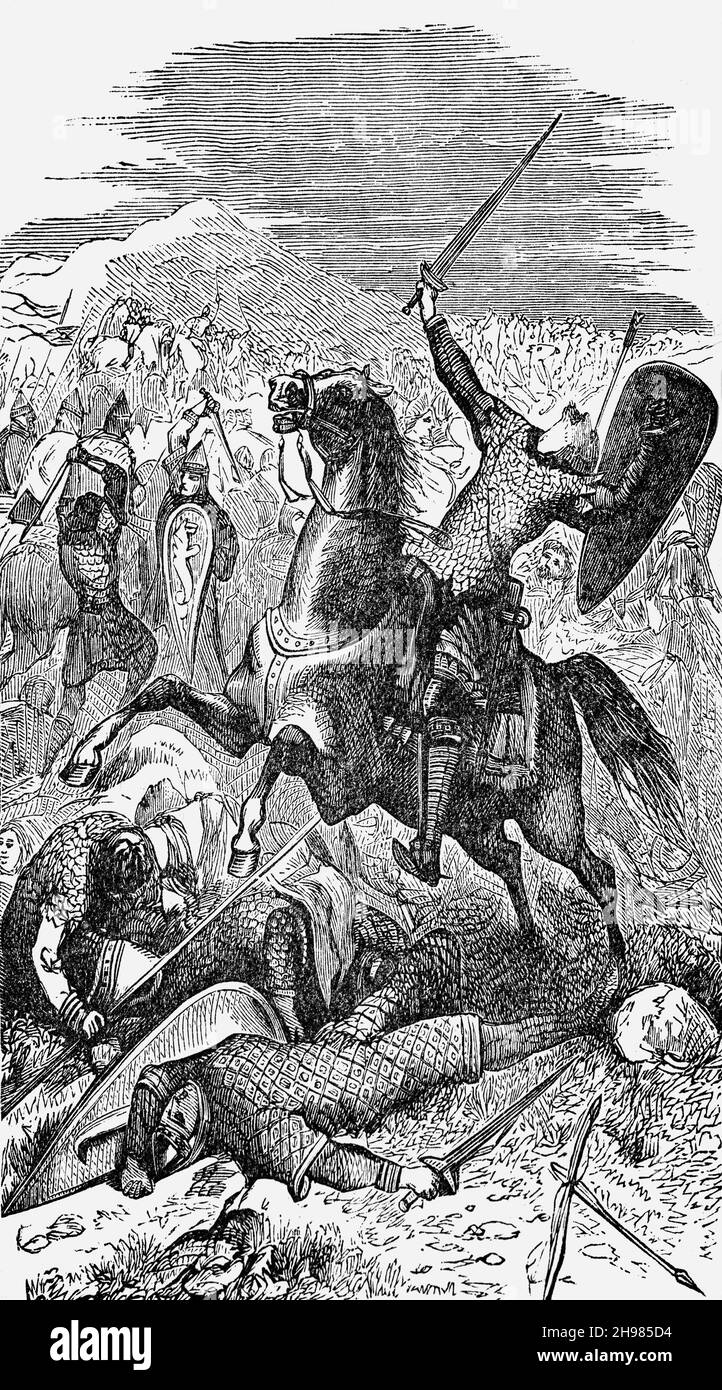 A late 19th Century illustration of the death of the Anglo-Saxon King Harold Godwinson (supposedly by an arrow in his eye) at the Battle of Hastings fought on 14 October 1066 between the Norman-French army of William, the Duke of Normandy, and an English army under Harold beginning the Norman conquest of England. It took place close to the present-day town of Battle, East Sussex, and was a decisive Norman victory. Stock Photohttps://www.alamy.com/image-license-details/?v=1https://www.alamy.com/a-late-19th-century-illustration-of-the-death-of-the-anglo-saxon-king-harold-godwinson-supposedly-by-an-arrow-in-his-eye-at-the-battle-of-hastings-fought-on-14-october-1066-between-the-norman-french-army-of-william-the-duke-of-normandy-and-an-english-army-under-harold-beginning-the-norman-conquest-of-england-it-took-place-close-to-the-present-day-town-of-battle-east-sussex-and-was-a-decisive-norman-victory-image453181376.html
A late 19th Century illustration of the death of the Anglo-Saxon King Harold Godwinson (supposedly by an arrow in his eye) at the Battle of Hastings fought on 14 October 1066 between the Norman-French army of William, the Duke of Normandy, and an English army under Harold beginning the Norman conquest of England. It took place close to the present-day town of Battle, East Sussex, and was a decisive Norman victory. Stock Photohttps://www.alamy.com/image-license-details/?v=1https://www.alamy.com/a-late-19th-century-illustration-of-the-death-of-the-anglo-saxon-king-harold-godwinson-supposedly-by-an-arrow-in-his-eye-at-the-battle-of-hastings-fought-on-14-october-1066-between-the-norman-french-army-of-william-the-duke-of-normandy-and-an-english-army-under-harold-beginning-the-norman-conquest-of-england-it-took-place-close-to-the-present-day-town-of-battle-east-sussex-and-was-a-decisive-norman-victory-image453181376.htmlRM2H985D4–A late 19th Century illustration of the death of the Anglo-Saxon King Harold Godwinson (supposedly by an arrow in his eye) at the Battle of Hastings fought on 14 October 1066 between the Norman-French army of William, the Duke of Normandy, and an English army under Harold beginning the Norman conquest of England. It took place close to the present-day town of Battle, East Sussex, and was a decisive Norman victory.
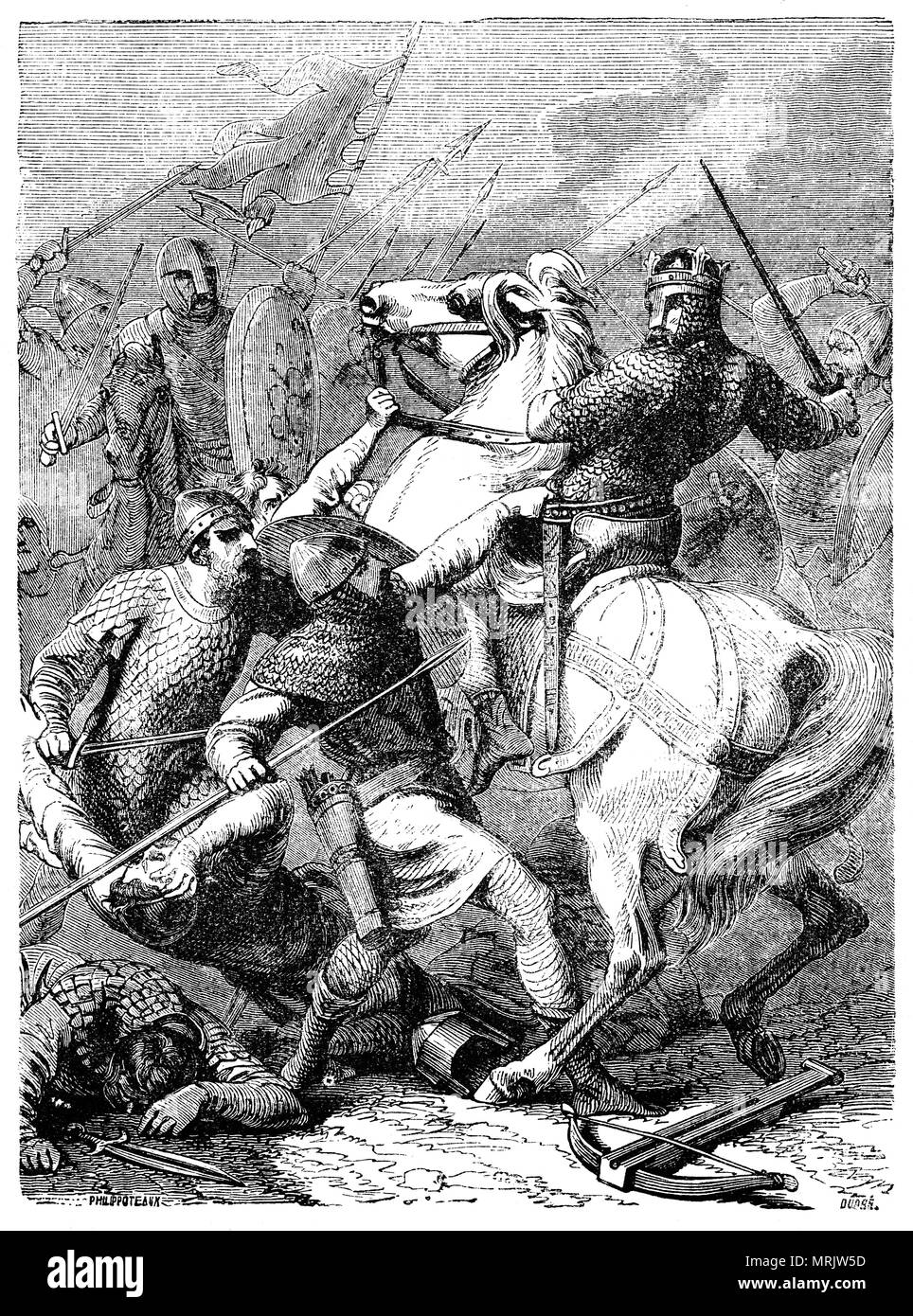 Captured at the Battle of Lincoln in 1141, King Stephen was abandoned by many of his followers and lost control of Normandy following invasion by the Empress Matilda and her half-brother Robert of Gloucester. Stephen was freed only after his wife and William of Ypres, one of his military commanders, captured Robert at the Rout of Winchester, but the war dragged on for many years with neither side able to win an advantage. Stock Photohttps://www.alamy.com/image-license-details/?v=1https://www.alamy.com/captured-at-the-battle-of-lincoln-in-1141-king-stephen-was-abandoned-by-many-of-his-followers-and-lost-control-of-normandy-following-invasion-by-the-empress-matilda-and-her-half-brother-robert-of-gloucester-stephen-was-freed-only-after-his-wife-and-william-of-ypres-one-of-his-military-commanders-captured-robert-at-the-rout-of-winchester-but-the-war-dragged-on-for-many-years-with-neither-side-able-to-win-an-advantage-image186655657.html
Captured at the Battle of Lincoln in 1141, King Stephen was abandoned by many of his followers and lost control of Normandy following invasion by the Empress Matilda and her half-brother Robert of Gloucester. Stephen was freed only after his wife and William of Ypres, one of his military commanders, captured Robert at the Rout of Winchester, but the war dragged on for many years with neither side able to win an advantage. Stock Photohttps://www.alamy.com/image-license-details/?v=1https://www.alamy.com/captured-at-the-battle-of-lincoln-in-1141-king-stephen-was-abandoned-by-many-of-his-followers-and-lost-control-of-normandy-following-invasion-by-the-empress-matilda-and-her-half-brother-robert-of-gloucester-stephen-was-freed-only-after-his-wife-and-william-of-ypres-one-of-his-military-commanders-captured-robert-at-the-rout-of-winchester-but-the-war-dragged-on-for-many-years-with-neither-side-able-to-win-an-advantage-image186655657.htmlRMMRJW5D–Captured at the Battle of Lincoln in 1141, King Stephen was abandoned by many of his followers and lost control of Normandy following invasion by the Empress Matilda and her half-brother Robert of Gloucester. Stephen was freed only after his wife and William of Ypres, one of his military commanders, captured Robert at the Rout of Winchester, but the war dragged on for many years with neither side able to win an advantage.
 U.S. soldiers landing on Utah Beach from the landing craft, June 6-8, 1944. During the Normandy invasion of France, World War Stock Photohttps://www.alamy.com/image-license-details/?v=1https://www.alamy.com/us-soldiers-landing-on-utah-beach-from-the-landing-craft-june-6-8-image69739368.html
U.S. soldiers landing on Utah Beach from the landing craft, June 6-8, 1944. During the Normandy invasion of France, World War Stock Photohttps://www.alamy.com/image-license-details/?v=1https://www.alamy.com/us-soldiers-landing-on-utah-beach-from-the-landing-craft-june-6-8-image69739368.htmlRME1CW7M–U.S. soldiers landing on Utah Beach from the landing craft, June 6-8, 1944. During the Normandy invasion of France, World War
 Final dress rehearsal for D-Day invasion of Normandy. U.S. troops landing on an English beach in training for invasion of Nazi Stock Photohttps://www.alamy.com/image-license-details/?v=1https://www.alamy.com/final-dress-rehearsal-for-d-day-invasion-of-normandy-us-troops-landing-image69739382.html
Final dress rehearsal for D-Day invasion of Normandy. U.S. troops landing on an English beach in training for invasion of Nazi Stock Photohttps://www.alamy.com/image-license-details/?v=1https://www.alamy.com/final-dress-rehearsal-for-d-day-invasion-of-normandy-us-troops-landing-image69739382.htmlRME1CW86–Final dress rehearsal for D-Day invasion of Normandy. U.S. troops landing on an English beach in training for invasion of Nazi
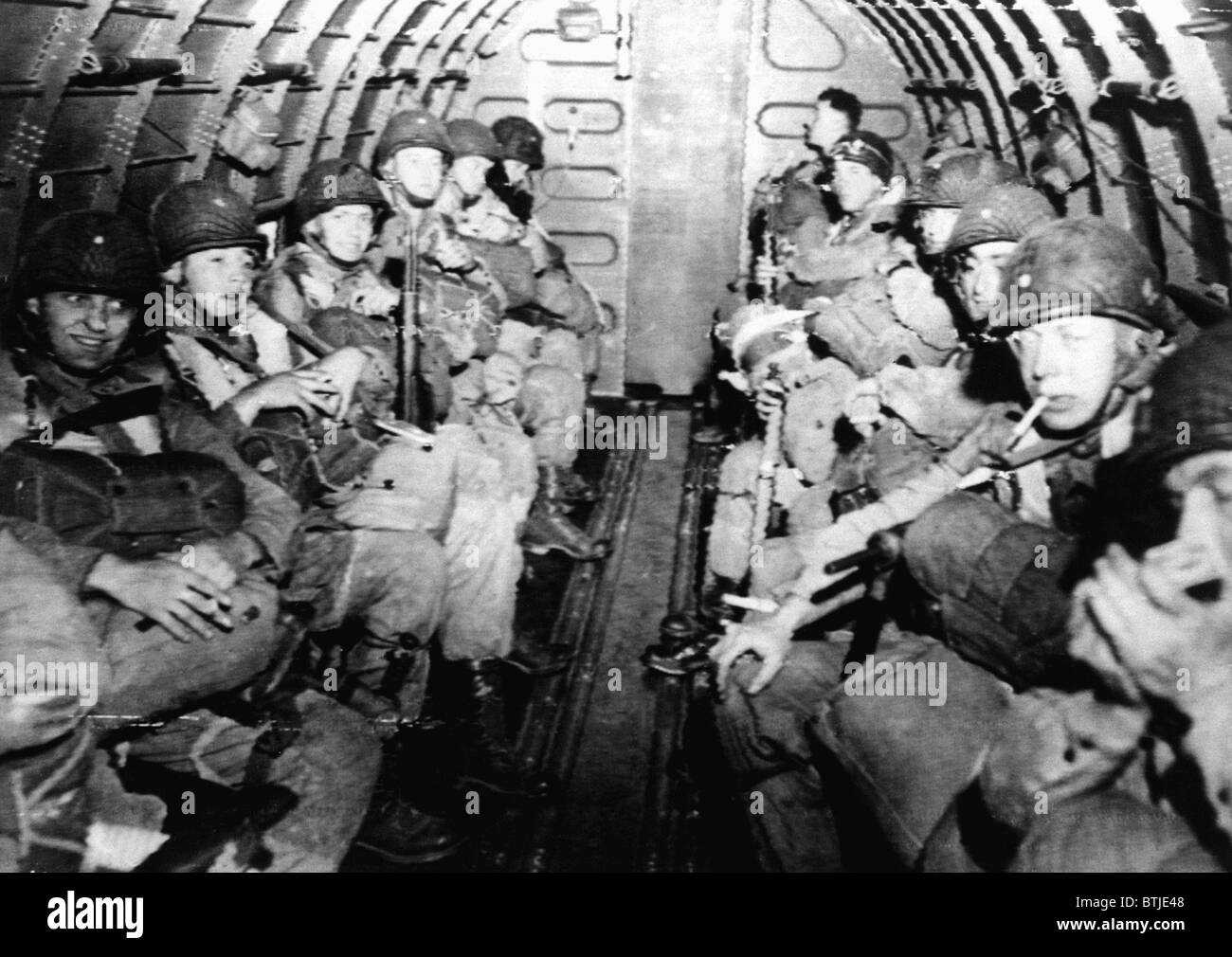 D-DAY, American Paratroopers flying over the English Channel enroute to the Normandy Invasion, 06/06/44 Stock Photohttps://www.alamy.com/image-license-details/?v=1https://www.alamy.com/stock-photo-d-day-american-paratroopers-flying-over-the-english-channel-enroute-32368344.html
D-DAY, American Paratroopers flying over the English Channel enroute to the Normandy Invasion, 06/06/44 Stock Photohttps://www.alamy.com/image-license-details/?v=1https://www.alamy.com/stock-photo-d-day-american-paratroopers-flying-over-the-english-channel-enroute-32368344.htmlRMBTJE48–D-DAY, American Paratroopers flying over the English Channel enroute to the Normandy Invasion, 06/06/44
 American soldiers help others whose landing craft was sunk off Utah Beach on D-Day. The survivors reached the beach of Stock Photohttps://www.alamy.com/image-license-details/?v=1https://www.alamy.com/american-soldiers-help-others-whose-landing-craft-was-sunk-off-utah-image69739365.html
American soldiers help others whose landing craft was sunk off Utah Beach on D-Day. The survivors reached the beach of Stock Photohttps://www.alamy.com/image-license-details/?v=1https://www.alamy.com/american-soldiers-help-others-whose-landing-craft-was-sunk-off-utah-image69739365.htmlRME1CW7H–American soldiers help others whose landing craft was sunk off Utah Beach on D-Day. The survivors reached the beach of
 First wave of U.S. invasion troops approach Omaha beach during the D-Day invasion of Normandy. There is a smoke screen on the Stock Photohttps://www.alamy.com/image-license-details/?v=1https://www.alamy.com/first-wave-of-us-invasion-troops-approach-omaha-beach-during-the-d-image69739362.html
First wave of U.S. invasion troops approach Omaha beach during the D-Day invasion of Normandy. There is a smoke screen on the Stock Photohttps://www.alamy.com/image-license-details/?v=1https://www.alamy.com/first-wave-of-us-invasion-troops-approach-omaha-beach-during-the-d-image69739362.htmlRME1CW7E–First wave of U.S. invasion troops approach Omaha beach during the D-Day invasion of Normandy. There is a smoke screen on the
 Silhouetted by helmets, view shows two landing craft at Omaha beach on D-Day. Each large ship landed 200 soldiers. June 6, Stock Photohttps://www.alamy.com/image-license-details/?v=1https://www.alamy.com/silhouetted-by-helmets-view-shows-two-landing-craft-at-omaha-beach-image69739361.html
Silhouetted by helmets, view shows two landing craft at Omaha beach on D-Day. Each large ship landed 200 soldiers. June 6, Stock Photohttps://www.alamy.com/image-license-details/?v=1https://www.alamy.com/silhouetted-by-helmets-view-shows-two-landing-craft-at-omaha-beach-image69739361.htmlRME1CW7D–Silhouetted by helmets, view shows two landing craft at Omaha beach on D-Day. Each large ship landed 200 soldiers. June 6,
 Allied soldiers evacuated from Normandy's beaches on a U.S. landing craft on D-Day. Ships landed tanks and vehicles, and Stock Photohttps://www.alamy.com/image-license-details/?v=1https://www.alamy.com/allied-soldiers-evacuated-from-normandys-beaches-on-a-us-landing-craft-image69739374.html
Allied soldiers evacuated from Normandy's beaches on a U.S. landing craft on D-Day. Ships landed tanks and vehicles, and Stock Photohttps://www.alamy.com/image-license-details/?v=1https://www.alamy.com/allied-soldiers-evacuated-from-normandys-beaches-on-a-us-landing-craft-image69739374.htmlRME1CW7X–Allied soldiers evacuated from Normandy's beaches on a U.S. landing craft on D-Day. Ships landed tanks and vehicles, and
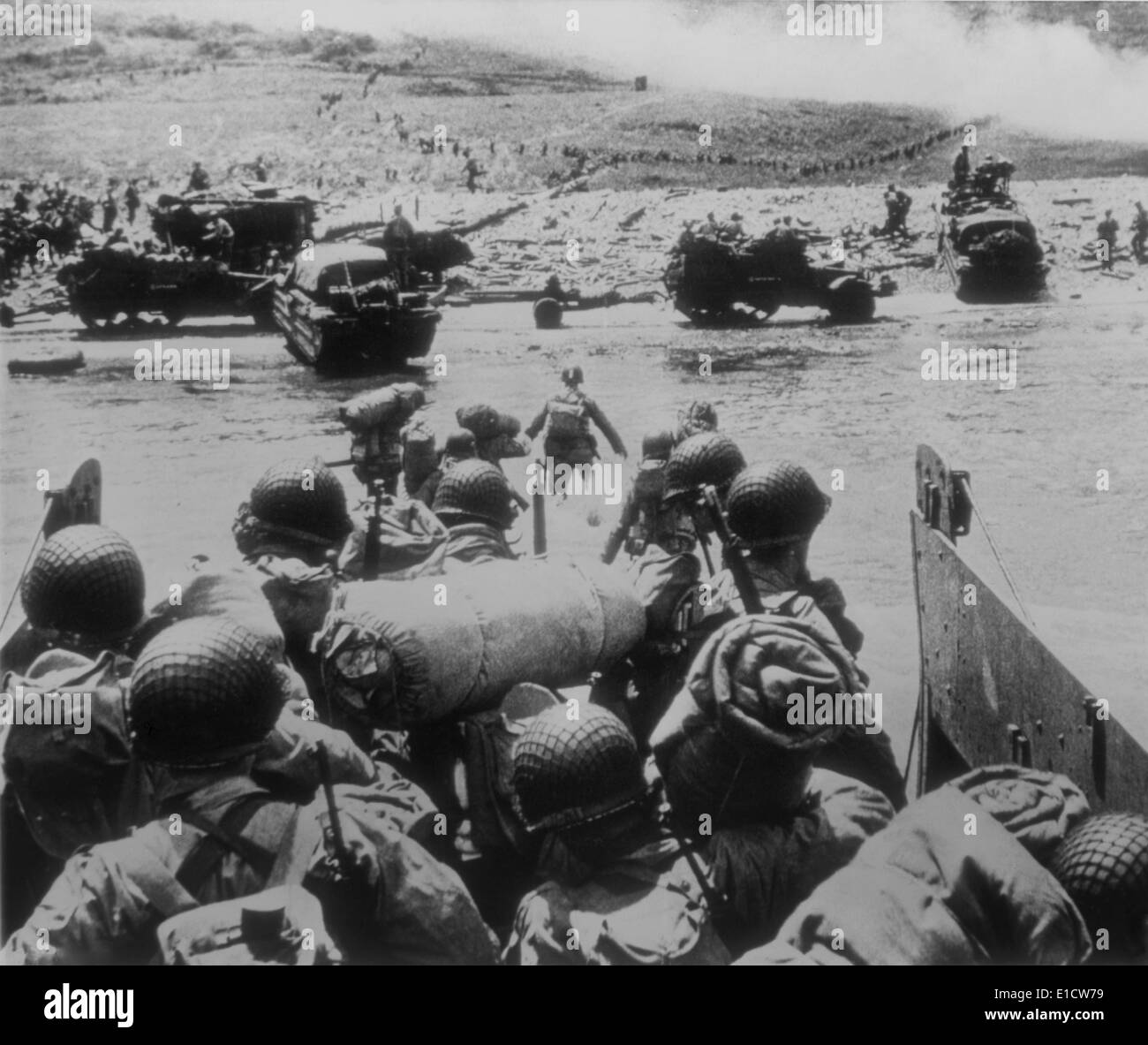 U.S. soldiers landing on Utah Beach, the westernmost landing of the D-Day invasions. In the distance soldiers move inland, as Stock Photohttps://www.alamy.com/image-license-details/?v=1https://www.alamy.com/us-soldiers-landing-on-utah-beach-the-westernmost-landing-of-the-d-image69739357.html
U.S. soldiers landing on Utah Beach, the westernmost landing of the D-Day invasions. In the distance soldiers move inland, as Stock Photohttps://www.alamy.com/image-license-details/?v=1https://www.alamy.com/us-soldiers-landing-on-utah-beach-the-westernmost-landing-of-the-d-image69739357.htmlRME1CW79–U.S. soldiers landing on Utah Beach, the westernmost landing of the D-Day invasions. In the distance soldiers move inland, as
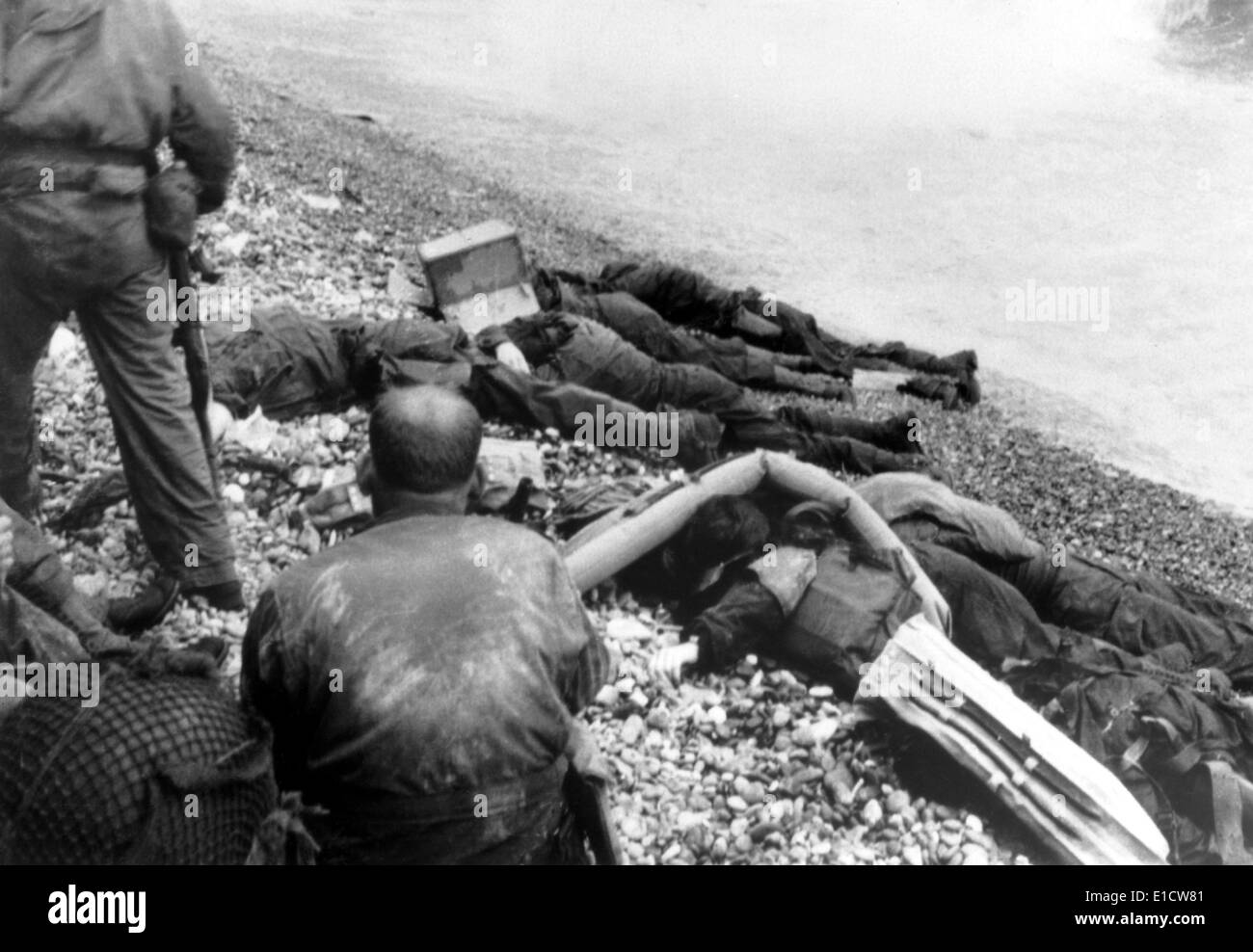 Dead U.S. soldiers Omaha beach on D-Day, June 6, 1944. Some bodies are covered with lifebuoys, and one of them has the face Stock Photohttps://www.alamy.com/image-license-details/?v=1https://www.alamy.com/dead-us-soldiers-omaha-beach-on-d-day-june-6-1944-some-bodies-are-image69739377.html
Dead U.S. soldiers Omaha beach on D-Day, June 6, 1944. Some bodies are covered with lifebuoys, and one of them has the face Stock Photohttps://www.alamy.com/image-license-details/?v=1https://www.alamy.com/dead-us-soldiers-omaha-beach-on-d-day-june-6-1944-some-bodies-are-image69739377.htmlRME1CW81–Dead U.S. soldiers Omaha beach on D-Day, June 6, 1944. Some bodies are covered with lifebuoys, and one of them has the face
 U.S. troops wading to Utah Beach during the D-Day invasion of Normandy on June 6-8, 1944. World War 2. (BSLOC 2014 2 23) Stock Photohttps://www.alamy.com/image-license-details/?v=1https://www.alamy.com/us-troops-wading-to-utah-beach-during-the-d-day-invasion-of-normandy-image69739359.html
U.S. troops wading to Utah Beach during the D-Day invasion of Normandy on June 6-8, 1944. World War 2. (BSLOC 2014 2 23) Stock Photohttps://www.alamy.com/image-license-details/?v=1https://www.alamy.com/us-troops-wading-to-utah-beach-during-the-d-day-invasion-of-normandy-image69739359.htmlRME1CW7B–U.S. troops wading to Utah Beach during the D-Day invasion of Normandy on June 6-8, 1944. World War 2. (BSLOC 2014 2 23)
 English townsfolk serve hot coffee to U.S. Army Ordnance men. They are awaiting their 'go' signal to join the ongoing invasion Stock Photohttps://www.alamy.com/image-license-details/?v=1https://www.alamy.com/stock-photo-english-townsfolk-serve-hot-coffee-to-us-army-ordnance-men-they-are-78824844.html
English townsfolk serve hot coffee to U.S. Army Ordnance men. They are awaiting their 'go' signal to join the ongoing invasion Stock Photohttps://www.alamy.com/image-license-details/?v=1https://www.alamy.com/stock-photo-english-townsfolk-serve-hot-coffee-to-us-army-ordnance-men-they-are-78824844.htmlRMEG6NW0–English townsfolk serve hot coffee to U.S. Army Ordnance men. They are awaiting their 'go' signal to join the ongoing invasion
 English townsfolk serve hot coffee to U.S. Army Ordnance men. They are awaiting their 'go' signal to join the ongoing invasion of France. July 24, 1944. World War 2. (BSLOC 2014 10 64) Stock Photohttps://www.alamy.com/image-license-details/?v=1https://www.alamy.com/stock-photo-english-townsfolk-serve-hot-coffee-to-us-army-ordnance-men-they-are-170508782.html
English townsfolk serve hot coffee to U.S. Army Ordnance men. They are awaiting their 'go' signal to join the ongoing invasion of France. July 24, 1944. World War 2. (BSLOC 2014 10 64) Stock Photohttps://www.alamy.com/image-license-details/?v=1https://www.alamy.com/stock-photo-english-townsfolk-serve-hot-coffee-to-us-army-ordnance-men-they-are-170508782.htmlRMKWB9KA–English townsfolk serve hot coffee to U.S. Army Ordnance men. They are awaiting their 'go' signal to join the ongoing invasion of France. July 24, 1944. World War 2. (BSLOC 2014 10 64)
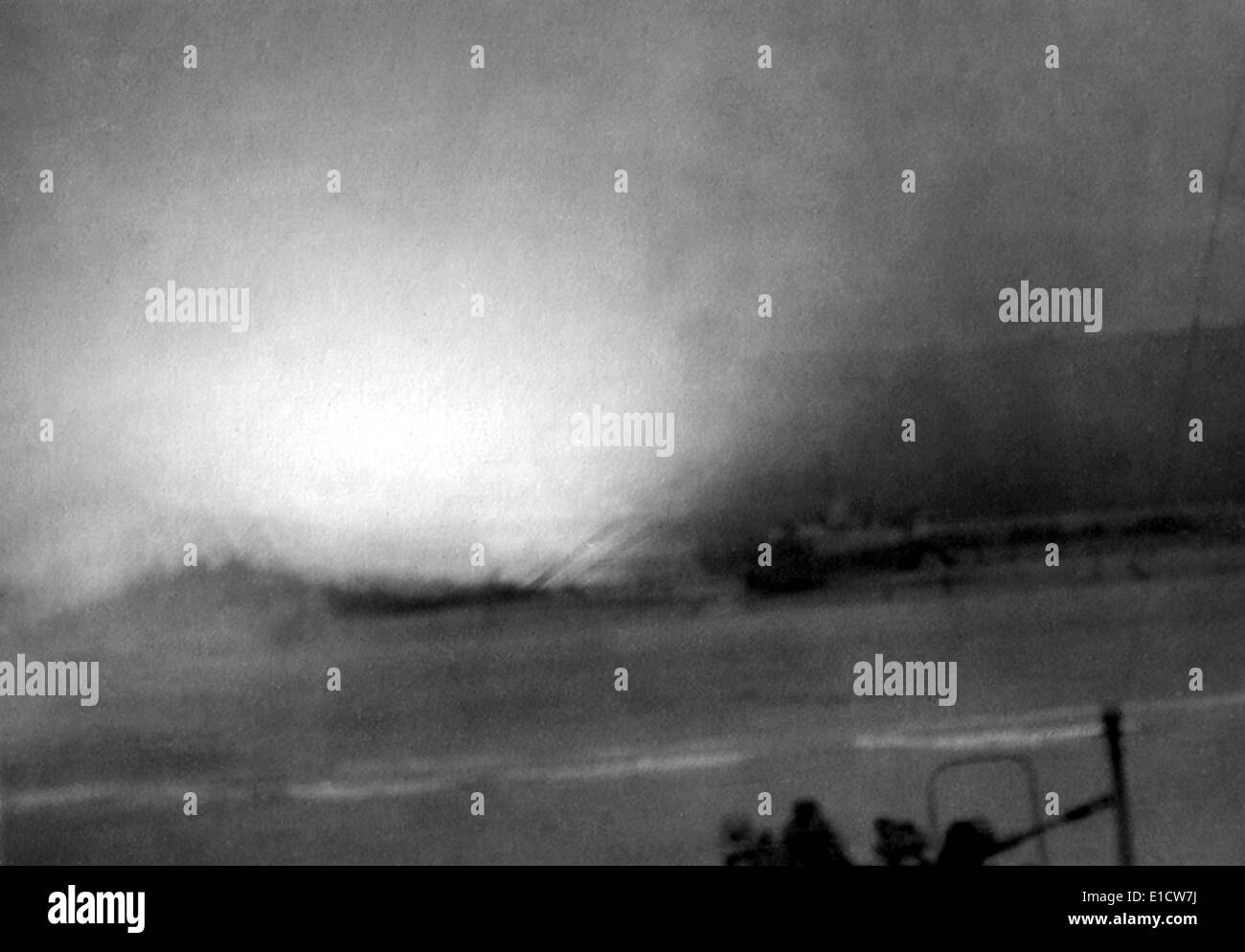 Large explosion near U.S. landing craft and soldiers assaulting Omaha Beach on D-Day. Photograph taken from a ship approaching Stock Photohttps://www.alamy.com/image-license-details/?v=1https://www.alamy.com/large-explosion-near-us-landing-craft-and-soldiers-assaulting-omaha-image69739366.html
Large explosion near U.S. landing craft and soldiers assaulting Omaha Beach on D-Day. Photograph taken from a ship approaching Stock Photohttps://www.alamy.com/image-license-details/?v=1https://www.alamy.com/large-explosion-near-us-landing-craft-and-soldiers-assaulting-omaha-image69739366.htmlRME1CW7J–Large explosion near U.S. landing craft and soldiers assaulting Omaha Beach on D-Day. Photograph taken from a ship approaching
 U.S. Army MP (Military Police) practices French on a ship taking him to Normandy. June 15, 1944. World War 2. (BSLOC 2014 2 77) Stock Photohttps://www.alamy.com/image-license-details/?v=1https://www.alamy.com/us-army-mp-military-police-practices-french-on-a-ship-taking-him-to-image69739396.html
U.S. Army MP (Military Police) practices French on a ship taking him to Normandy. June 15, 1944. World War 2. (BSLOC 2014 2 77) Stock Photohttps://www.alamy.com/image-license-details/?v=1https://www.alamy.com/us-army-mp-military-police-practices-french-on-a-ship-taking-him-to-image69739396.htmlRME1CW8M–U.S. Army MP (Military Police) practices French on a ship taking him to Normandy. June 15, 1944. World War 2. (BSLOC 2014 2 77)
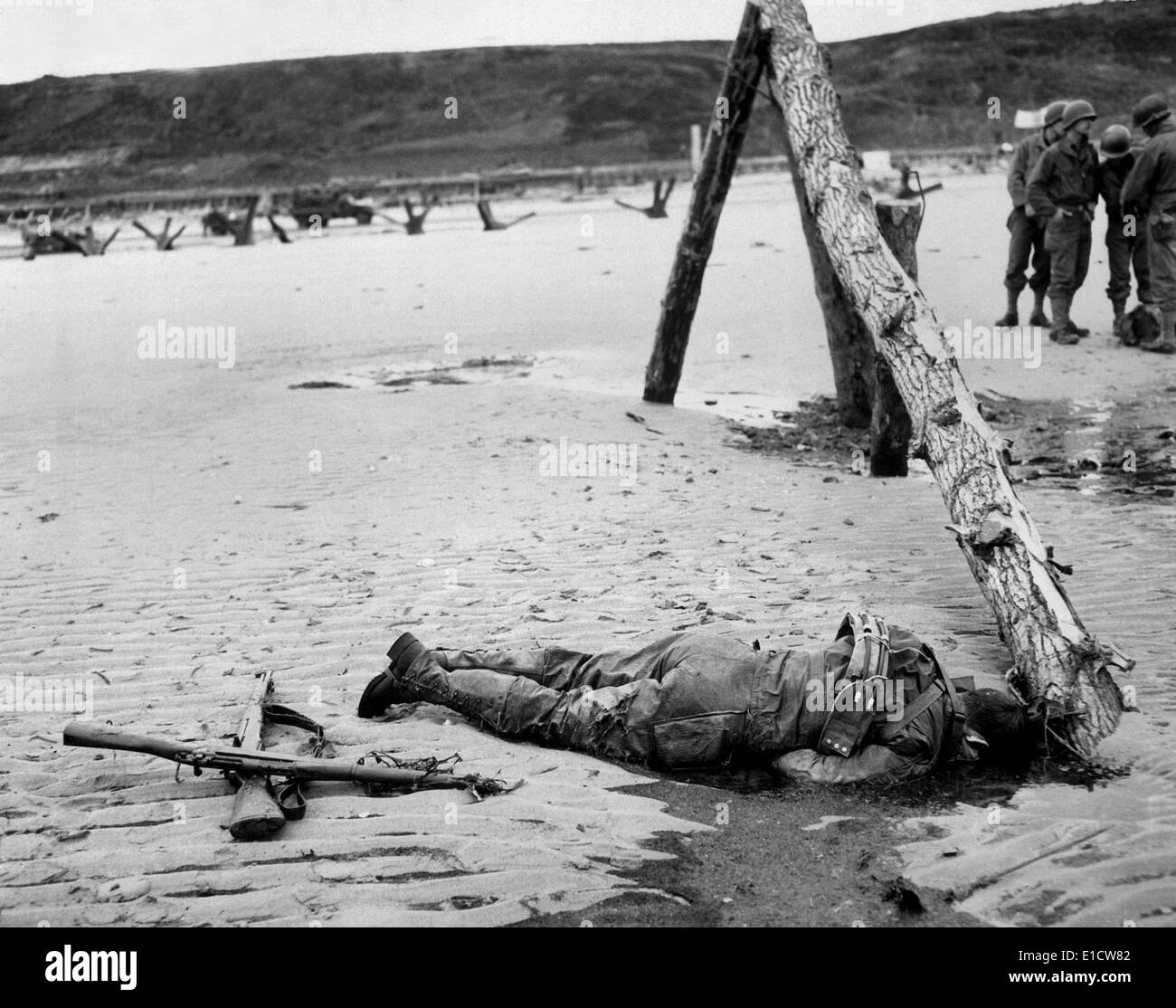 Dead U.S. soldier on Omaha beach on D-Day, June 6, 1944. Crossed rifles in the sand are a comrade's tribute. He was killed Stock Photohttps://www.alamy.com/image-license-details/?v=1https://www.alamy.com/dead-us-soldier-on-omaha-beach-on-d-day-june-6-1944-crossed-rifles-image69739378.html
Dead U.S. soldier on Omaha beach on D-Day, June 6, 1944. Crossed rifles in the sand are a comrade's tribute. He was killed Stock Photohttps://www.alamy.com/image-license-details/?v=1https://www.alamy.com/dead-us-soldier-on-omaha-beach-on-d-day-june-6-1944-crossed-rifles-image69739378.htmlRME1CW82–Dead U.S. soldier on Omaha beach on D-Day, June 6, 1944. Crossed rifles in the sand are a comrade's tribute. He was killed
 Medics administer a plasma transfusion to a wounded soldier on Omaha Beach on D-day. He is a survivor of a landing craft sunk Stock Photohttps://www.alamy.com/image-license-details/?v=1https://www.alamy.com/medics-administer-a-plasma-transfusion-to-a-wounded-soldier-on-omaha-image69739370.html
Medics administer a plasma transfusion to a wounded soldier on Omaha Beach on D-day. He is a survivor of a landing craft sunk Stock Photohttps://www.alamy.com/image-license-details/?v=1https://www.alamy.com/medics-administer-a-plasma-transfusion-to-a-wounded-soldier-on-omaha-image69739370.htmlRME1CW7P–Medics administer a plasma transfusion to a wounded soldier on Omaha Beach on D-day. He is a survivor of a landing craft sunk